Highlighted
Professional
Collections
Part of the Clio Network
ADVERTISING
Tourism Authority of Thailand

Amazing Thailand - Culture to Commerce
Agency: Ogilvy Group Thailand

Description
Winner of a 2023 Clio Gold Award for Cultural Experiences This winning entry titled 'Amazing Thailand. Culture to Commerce' was entered for Tourism Authority of Thailand by Ogilvy Group Thailand, Bangkok. The advertising agency is part of the agency network: Ogilvy and holding company: WPP Group. How a gaming experience turned Thailand’s Deep Culture into a destination where pop culture meets commerce CHALLENGE The number of visitors to Thailand have plummeted due to the pandemic’s impact, which resulted in the loss of significant sources of income that most temples, affiliated small businesses and local communities depended upon. The Tourism Authority of Thailand needed an idea that could help sustain the living home of Thailand’s deep culture. OPPORTUNITY What if the popularity of the previous HSH2 game could be leveraged? By tapping into the millions of players around the world and combining it with the global craze that Thailand’s spiritual artifacts have gained over the past years, we could turn gamers into virtual visitors in a place where pop culture meets commerce. SOLUTION The Tourism Authority of Thailand to introduce ‘Home Sweet Home - Survive Obt2’, a multiplayer game that builds on the success of its previous version by taking the gaming experience to the next level and turning it into a gateway that interconnects the virtual world, the spiritual world and the real world for the first time. In addition to a totally new journey of discovery into Thailand’s deep culture, where gamers from anywhere around the globe could immerse themselves in age-old beliefs and explore the numerous sacred temples and sanctuaries inside-out, this new version engaged players on a deeper level by giving them the chance to virtually take part in ancient rituals, interact with a range of sacred objects and even use supernatural powers from the various hidden amulets they would unexpectedly uncover during the gameplay, to help them stay protected and fight against the evil forces within the game. Moreover, as gamers learnt more about the fascinating superpowers of each amulet, occult rituals and spiritual activities, they were offered a unique chance to get their hands on their favorite amulets and other sacred items through a link to the Tat website within the game, where they could easily purchase and get their items delivered, or even book certain activities they wished to experience in real life. IMPACT As a result of ‘Home Sweet Home – Survive Obt2’ becoming the new craze among gamers worldwide, the hope of all the temples and affiliated small businesses was revived by a new form of sustainable virtual tourism. • 368 million YouTube, Twitch and Bilibili views • 270 million media impressions • 142 million earned media value and rising • 246% increase in time spent on TAT’s website • Traffic to TAT’s website up 50x • On average players spend 15 minutes on a journey to deep culture in game • +300% site visitors converted into shoppers.
This professional campaign titled 'Amazing Thailand - Culture to Commerce' was published in Thailand in May, 2023. It was created for the brand: Tourism Authority of Thailand, by ad agency: Ogilvy Group Thailand. This Integrated medium campaign is related to the Recreation, Leisure and Travel and Tourism industries and contains 2 media assets. It was submitted over 1 year ago.
Agency Network Ogilvy Holding Company WPP Group Production Company Yggdrazil Group Public Company Limited, Bangkok Advertiser Brand Tourism Authority of Thailand, Bangkok Advertising Agency Ogilvy Group Thailand, Bangkok Entrant Company Ogilvy Group Thailand, Bangkok Chairman Nopadol Srikieatikajohn / Ogilvy Group Thailand Executive Creative Director Andrew Chu / Ogilvy Group Thailand Creative Director Puripong Limwanatipong / Ogilvy Group Thailand Creative Director Thanawat Chongmahakul / Ogilvy Group Thailand Art Director Nopadol Srikieatikajohn / Ogilvy Group Thailand Art Director Puripong Limwanatipong / Ogilvy Group Thailand Art Director Pannawee Saibua / Ogilvy Group Thailand Copywriter Pongsakon Junrueng / Ogilvy Group Thailand Copywriter Visaya Sosothikul / Ogilvy Group Thailand Producer Sakonpob Sinsuk / Ogilvy Group Thailand Digital Director Suparrerk Kulintaraprasert / Ogilvy Group Thailand Digital Director Noprada Jirarattanapan / Ogilvy Group Thailand Managing Director Jiravara Virayavardhana / Ogilvy Group Thailand Strategic Planning Director Sasipa Mongolnavin / Ogilvy Group Thailand Strategic Planner Jirat Tangvichacharn / Ogilvy Group Thailand Account Manager Sakon Suksophon / Ogilvy Group Thailand Game Creative Director Saroot Tubloy / Yggdrazil Group Head of Game Development Nattaworn Tancharoen / Yggdrazil Group Producer Jitpisut Sirirat / Yggdrazil Group Project Manager Panadda Rittrirat / Yggdrazil Group Project Manager Aunchaya Thanapornkaitikul / Yggdrazil Group Technical Artist Waroon Pumisiricharoen / Yggdrazil Group Technical Artist Kittichon Kittiwan / Yggdrazil Group Technical Artist Jiranuwat Meksutat / Yggdrazil Group Quality Assurance Akara Thiengphuengtham / Yggdrazil Group

Related Campaigns

The Unexpected

The Casting Call

Rehearsal, Auntie Samorn

All-New, All In One Place.

End Of Being Tortured

The Tattoo Flyer
Sign up for our newsletter
Don't miss out. Receive our free weekly newsletter to learn about the best creative work from all around the globe. We're keeping your email safe and confidential.

Welcome. Choose your creative path below.

Enter awards, view winners galleries, access entry details, and buy event tickets.

Browse the most creative advertising from every corner of the world.

Read about the latest campaigns and get insights from creators.

Tourism Authority of Thailand
Advertisement
Amazing New Chapters, Thailand’s new commitment to sustainability and safety entices a fresh wave of tourists.
Reopened with no quarantine requirement, Thailand now allows fully vaccinated tourists to rediscover the Kingdom’s bustling cities, natural wonders and solemn serenity in complete safety. Whilst the world heals, Thailand has been reinventing itself, incorporating BCG (bio-economy, circular economy, and green economy) into their new sustainable tourism model, and upgrading their health monitoring infrastructure to thrive in the new normal. Opened to the world on the 1 st of November, Thailand provides a uniquely smooth and seamless travel experience for tourists, full of new sights, smells and sounds in these Amazing New Chapters.

Streamlined Screening Procedures
Under the new Test & Go scheme, travellers from 63 countries and territories are now permitted to enter Thailand with stringent safety requirements. Along with the need to be vaccinated, tourists are required to undergo testing before they board, and after they arrive in Thailand. Though a norm for most countries, Thailand has taken the hassle and confusion away from the travellers, and mobilizing much of the health services into a traveller-first approach under the improved Amazing Thailand Safety and Health Administration (SHA) Standard. The key to their success is expanding their quarantine bubbles into a mobile force of regulated services that allow travellers to forego their initial testing at a pre-defined designated area, to be instead completed in the comfort of a hotel room. Along with their MorChana alert application, this flexible system creates a unique and traceable quarantine bubble around each traveller throughout their journey. A fluid system like this allows for much greater freedoms for any travellers, though it still relies heavily on a backbone of dedicated front-line workers that assist at every step along the new Test & GO system. Thankfully the economic benefits seem to make this trade off worth it for most Thai people, and appealing for all visitors.

From Sandbox to Blue Zones
With the success of the Phuket Sandbox and Samui Plus scheme launched in July 2021, Thailand has increased the number of Blue Zones to now include 17 more destinations that are ready to welcome fully vaccinated travellers from any country. This includes the metropolis of Bangkok, the tropical paradise of Krabi and the rolling hills of Chiang Mai.

Once tested negative for COVID-19, tourists can immediately start exploring the sights inside a Blue Zone. After an initial 7 day required stay inside a blue zone; which is far too little time to truly explore everything each one of these biodiverse and culturally rich locations have to offer, tourists are free to leave the Blue Zone and explore other parts of Thailand. Enticing visitors further, application is even easier for travel to the Blue Zone, with the guideline available on the Tourism Authority of Thailand’s website https://www.tatnews.org . All of these factors have shown that through technology, travel through the global pandemic can soon return to what it was before.

Amazing New Chapters
Next year, will mark new chapters for Thailand, celebrating “Visit Thailand Year 2022” with the world. Adopting the Bio-Circular-Green or BCG economy model and an ongoing promotion of responsible and sustainable tourism, new marketing activities for the next year will emphasise Thailand’s strengths in biological diversity and cultural richness under the “Amazing New Chapters” concept . This will reiterate the good image of the kingdom as a top tourist destination with all health and safety measures in place as the world exits the COVID-19 era.

Gastronomy has received an organic overhaul, with initiatives promoting the use of locally grown ingredients and encouraging tourists to become part of the food experience. New organic farms, have popped up nationwide allowing tourists a hands-on experience with harvesting, preparing and tasting Thailand’s famous cuisine. This initiative doesn’t stop there, after all, a few farms for tourists to visit will have little to no change on the core economic process. The difference will come from the education and support from local farmers, incentivising them to produce organically and with deference to the environment. Leveraging blockchain technology, the new smart app TOCA Platform allows tourists and Thai residents alike to trace the origins of the produce they buy, allowing transparency through the entire supply chain, and providing a platform for farmers to build a name for their products that tourists will want. Thailand has always been famed for its luscious beaches and care-free lifestyle, however the pandemic has pushed everyone to their extremes. Thailand has emerged with a new plan, not just reopening the country to tourists, but also creating a robust and technologically marvellous system to keep everyone safe. The abundance of tourism products and services in Thailand will fulfil all travel desires, because from A to Z, Thailand has it all.

The news and editorial staff of The New York Times had no role in this advertisement’s creation.
- Currency Conversion
- Bangkok Weather
- Privacy Policy
- Cookie Policy (EU)

Thai PM Thai PM to lead new cabinet ministers in oath-taking ceremony on Friday

Thai Airways says its Airbus A350 engines are trouble-free

Russian Man Found Dead in Phuket, Police Suspect He was Murdered

Phuket Court Acquits Swiss Man for Kicking Thai Woman Doctor

Saudi Man Drowns at Phuket Beach

Nearly 30 Missing After Boat Capsizes in Mekong River

When Places Become Brands! An art of place branding to increase value, revenue and sustainability
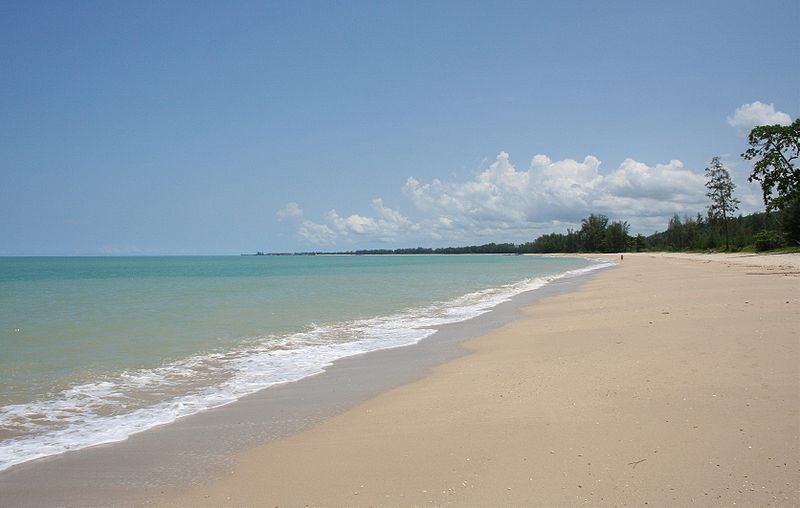
TAT Launches ‘Amazing Thailand: Your Stories Never End’ to Boost Tourism
BANGKOK (NNT) – The Tourism Authority of Thailand (TAT) recently introduced its new initiative, “Amazing Thailand: Your Stories Never End,” at the Thailand Travel Mart Plus (TTM+) 2024 in Khao Lak, Phang Nga province. TAT Deputy Governor for Marketing Communications Nithee Seeprae spearheaded the launch, inviting tourists to share their memorable experiences in Thailand.
Tourism revenue to miss state target by B500bn
The campaign showcases an array of luxury travel options, including accommodations in pool villas in Phuket and Phang Nga, treehouse villas on secluded islands, and gastronomic tours featuring both local flavors and Michelin-starred cuisine. Cultural and natural opulence is highlighted in northern Thailand, with Chiang Mai and Chiang Rai offering pontoon rides on the Mekong River, stays in upscale tented camps, and tours of historic Lanna sites.
Full story: National News Bureau of Thailand
Krajangwit Johjit National News Bureau of Thailand
Share this article:
The main purpose of Thailand News is to offer our readers all news from the most popular and trusted newspapers in Thailand & Asia in one place.
Get breaking news and the latest news headlines from Bangkok, Phuket, Pattaya, Chiang Mai, Northern Thailand, Isan, the insurgency-plagued South and Asia.
You May Also Like

More From Author

+ There are no comments

Two big bike riders killed by 18-wheeler in Phetchaburi

Thai FDA orders recall of 15 children’s syrups from the market
You may also like:.

Thai tourism authority’s new ad takes tourists on a cinematic journey of its tourist spots
August 8, 2022.
Get ready to explore the future of marketing and elevate your business! The ‘ What’s NEXT in Marketing 2024-2025 ’ series is heading to Indonesia , Malaysia , the Philippines , and Singapore . Don’t miss out!
Bangkok, Thailand – With the tourism industry in Thailand reopening recently, the Tourism Authority of Thailand (TAT) has launched a new campaign via BBDO Bangkok which depicts a trilogy of cinematic trailers, from adventure, to romance to an action-packed sci-fiction, where the viewer follows the different characters on their unique, but thrilling journeys through Thailand.
Knowing that tourists love to share their travel experiences on social media, BBDO Bangkok wanted to build on this and simply invite people to come to Thailand and “Write Their New Chapter” in cinematic style, as Thailand writes theirs.
This campaign is just the beginning of Tourism Authority of Thailand’s marketing push. Furthering the promotion of this new campaign, BBDO Bangkok is releasing thematic key visuals, Instagram filters in the style of movie release posters, and tour packages to encourage tourists to come to Thailand to create and share their new chapters using hashtags like #AmazingNewChapters and #AmazingThailand.
Speaking about the ad concept, Thasorn Boonyanate, chief creative officer at BBDO Bangkok told TAT that they are not coming here to pitch against other agencies, but rather to pitch against other countries. For him, travellers need to revisit Thailand to see that nature, hotels, and restaurants have revived.
“People love to record special moments on their phones, whether it’s a story on Instagram or a video on Facebook. Just like movie genres, what they capture can be adventure, romance, or pure comedy. Drawing inspiration from our campaign, and using tools like our new filters, we want them to take on the role of film producers, create and tell their stories, and share this chapter of their lives with the world,” Boonyanate said.
Meanwhile, Yuthasak Supasorn, governor at TAT , commented, Representing film, this latest TVC is a new approach we are taking to communicate the ‘Amazing New Chapters’ message and to engage tourists around the world through a cinematic perspective to show them Thailand has a multitude of holiday possibilities in which there is something for all.”
He added, “We want to inspire tourists to explore our wonderful country and to create their own amazing chapters during their stay and premier these films with not just friends and family, but the rest of the world.”
Related Articles
Featured articles, most recent articles, subscribe now.
- First Name (Required)
- Email (Required)
- I agree to the Terms & Conditions , Privacy Policy and Cookie Policy
- Comments This field is for validation purposes and should be left unchanged.
Privacy Overview

- Change to white mode
- Change to normal mode
- Change to text yellow mode

“5 Approaches” strategy to attract new tourists and stimulate the economy.

“5 Approaches” strategy to attract new tourists and stimulate the economy
After the success of Thai tourism in 2022, after the relaxation of COVID-19 measures, more than 11.8 million foreign tourists flocked to Thailand in 2022. So 2023 should be a golden year for Thailand to revive the economy with tourism. At the same time, agencies related to the tourism sector are ready to push forward the development of products and services. The Tourism Authority of Thailand (TAT), in particular, is driving the “Visit Thailand Year 2023: Amazing New Chapters” project to provide a superior travel experience, make an impression on visitors, and make Thailand a valuable travel destination. It has formulated important strategies for developing tourism for the international market, such as the “5 Approaches” strategy:
- “China is Back” welcomes the opening of the country for Chinese tourists. The goal is to create a good impression both in terms of quality and safety for new groups of tourists, accelerating the increase of airline seats, including promoting travel across the country by land in all channels;
- “7 Digits Target Tourism Development,” focusing on countries with high growth potential, including China, Malaysia, India, and South Korea;
- “Color Your Life by Amazing Thailand”: Creation of selling points under the concept of Amazing Thailand in order to become a part and be close to tourists (Slice of Life) through marketing promotion activities, both on-ground and virtual;
- “Responsible Tourism” supports tourism that is socially and environmentally responsible through the “Reborn the Nature” project;
- “Second Tier, Second to None” increases market opportunities by expanding the tourism area to secondary cities in Thailand and expanding the market for new tourists (First Visit) from secondary cities of various countries such as South Korea, China, India, Vietnam, and Malaysia.

Most Popular

How to buy train tickets online

Bringing Thai or foreign currency into or out of the Kingdom
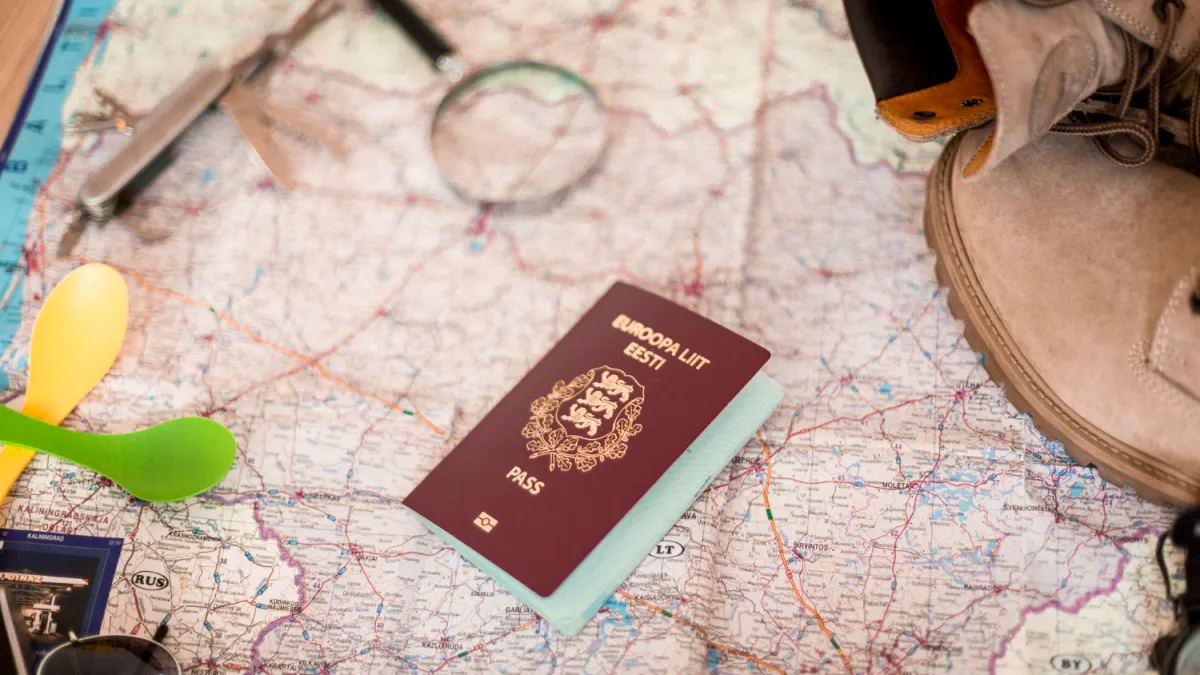
Countries/Territories entitled for visa exemption for a visit of not exceeding 30 days
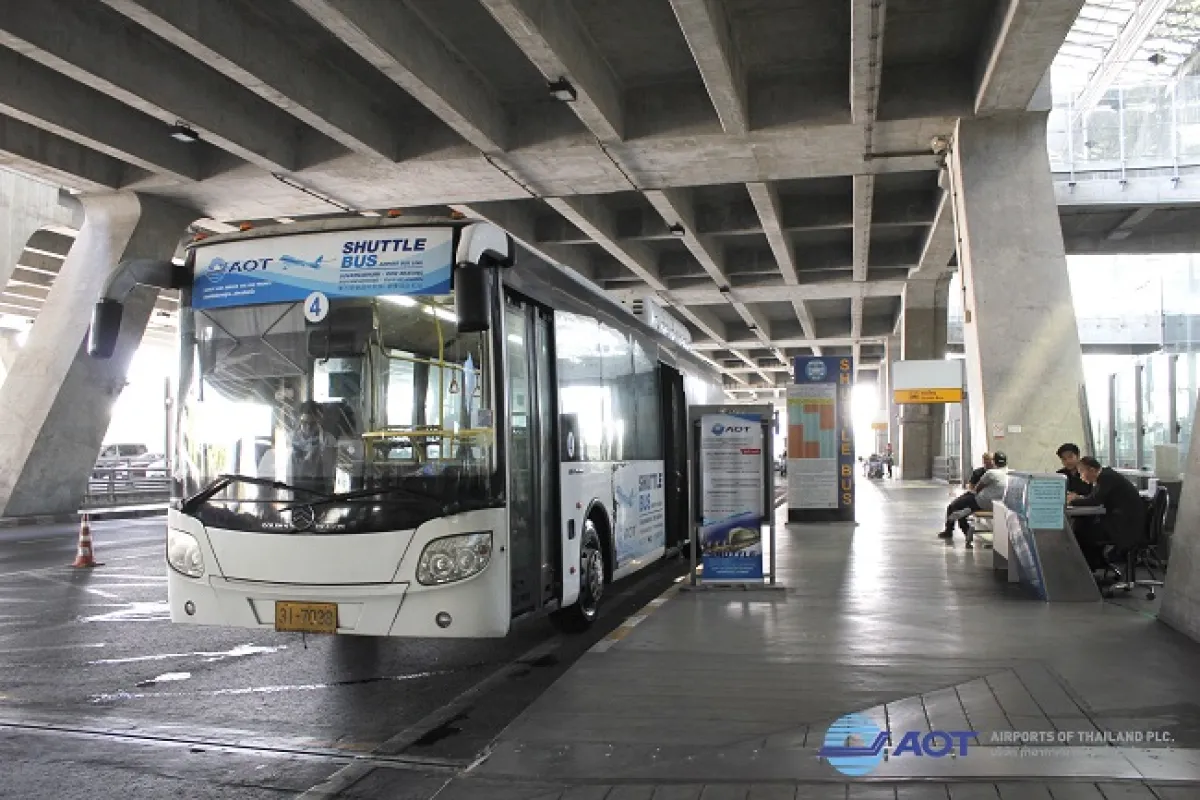
Don Mueang - Suvarnabhumi free airport shuttle bus

Thailand Biggest Fair 2023 (6-14 May)

Travel calendar – Pilates Day Thailand 2023 (6-7 May 2023)

Travel calendar – Beauty and the Beast in concert (20-21 May 2023)

TAT And Alipay+ Launch Thrilling New Platforms To Boost Thailand Tourism
Thursday, May 16, 2024

Tags: Alipay+ , Chinese tourists , digital travel , mobile payments , Thailand Tourism , Tourism Authority of Thailand , Tourism Innovation , travel technology
Subscribe to our Newsletters

Related Posts
- Exclusive Offers Galore: BEAUTY&YOU Teams Up with Alipay+ for Seamless Payments at Hong Kong International Airport
- According to Alipay+ Malaysia Ranked 5th Globally as Chinese Travelers Destination of Choice in CNY 2024
- Thailand Tourism Partners with Alipay+ to Boost Visitor Numbers During Chinese New Year Celebrations
- Singapore Becomes Hotspot for Chinese New Year, Sees Rise in Alipay+ Transactions
- Alipay+ launches 2024 global travel drive for Chinese new year, targets 8 million merchants

Select Your Language

I want to receive travel news and trade event update from Travel And Tour World. I have read Travel And Tour World's Privacy Notice .
REGIONAL NEWS

Elite Airport Taxi Introduces Premium Airport Transfers Across the UK, Promising
Wednesday, September 4, 2024

Norse Atlantic Airways Sets New Records this August By Carrying 191,291 Passenge
Tuesday, September 3, 2024

Luxury Travel Recognized: YC Travel Wins Best of Florida

Holland America’s New Grand Voyages: How Global Travelers Can Explore Anta
Middle east.

UAE, Thailand, And Bhutan Emerge As Top Picks For Indian Travelers, New Report F

Pinasbooking Offers New Freelance Travel Agent Roles in the U.A.E.

Karnataka Tourism Unveils Exclusive Experiences in San Francisco

Flights to Kathmandu Become Safer as IndiGo Introduces New RNP AR System
Privacy overview.
Visitors to Thailand will soon have to pay a $14 entry fee which will go towards a 'tourism transformation fund,' report says
- Thailand will reportedly introduce a $14 entrance fee to foreign visitors in 2022.
- The fee will go towards a "tourism transformation fund," the Bangkok Post reports.
- The fund will help the country recover from mass tourism.

Thailand will reportedly introduce an entrance fee in 2022 as part of a bid to transform the tourism industry.
According to the Bangkok Post, visitors will be charged 500 baht, or around $14, which will go towards a "tourism transformation fund." The fund will aid projects that "transform the industry" with a focus on high-value and sustainable tourism, the publication reports.
The publication added that The National Tourism Policy Committee approved the fund earlier this year, and the proposed fee was initially 300 baht, or around $8, per person.
Yuthasak Supasorn, governor of the Tourism Authority of Thailand (TAT), said that the additional 200 baht, or around $6, will fund projects in the private sector that will help the country restructure from mass tourism, as well as tourism-focused initiatives with an environmental focus, according to the publication.
Supasorn said the goal is to collect 5 billion baht, about $147 million, in the fund's first year, with a prediction of 10 million foreign arrivals to the country in 2022.
"The projects should be co-creations and the government should use the fund to support projects that can create an economic impact. The proportion of public-private financial support could be 50:50, 60:40, or 70:30, depending on how much we want to make those projects happen," Supasorn told the publication.
The TAT did not immediately respond to Insider's request for comment.
Watch: You can easily climb up this sticky waterfall in Thailand
- Main content

- China Daily PDF
- China Daily E-paper
- Asia-Pacific
- Middle East
- China-Europe
- China-Japan
- China-Africa

Thailand launches tourism promotion campaign to boost economy

BANGKOK - Thailand's tourism authority on Thursday announced an annual plan to boost its economy through elevated and experience-based tourism.
Under the theme of "Amazing New Chapters", the new campaign aims for a full resumption of Thai tourism this year, which is expected to generate about 2.38 trillion baht ($71.12 billion), or 80 percent of the pre-pandemic level, Tourism Authority of Thailand (TAT) Governor Yuthasak Supasorn told a news conference.
The beyond-goal achievement of tourism last year, with a total of 11.8 million foreign arrivals and 189 million domestic trips, reflected very positive signs for the tourism recovery, Yuthasak said.
For the Chinese and other international markets, the TAT will move forward by focusing on new segments of tourists, easing airline seat shortages, and promoting overland journeys, Deputy TAT Governor Tanes Petsuwan told the briefing.
The TAT will be working with airlines to help resume flights between Thailand and China as there are about 70 percent fewer flights compared to 2019, Tanes said.
"Aside from road connectivity in the north, the China-Laos railway is now a game changer, connecting China's southern region to the northeastern part of Thailand," he said.
According to the TAT, the Southeast Asian kingdom is expected to welcome around 25 million international arrivals this year, with 5 million of them being Chinese tourists.
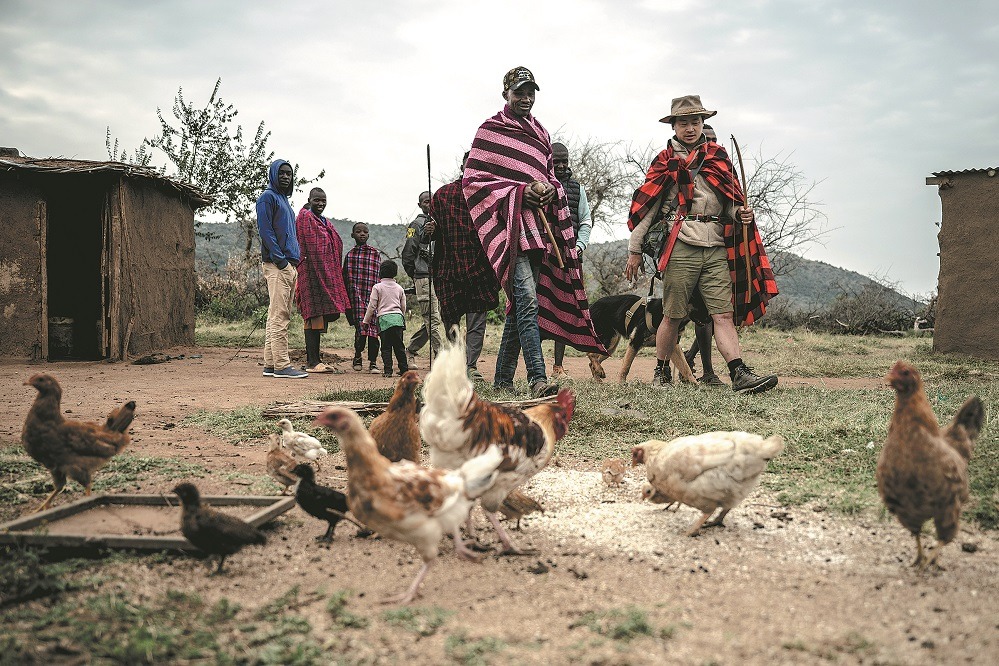

TAT confident of achieving THB 3 trillion in tourism revenue
Governor acknowledges reduced spending power but says increase in tourist numbers, both foreign and local, will compensate.
The Tourism Authority of Thailand (TAT) announced on Tuesday that it is confident that Thailand will achieve its tourism revenue target of 3 trillion baht, which is around 30% higher than 2023.
Around 2 trillion baht would be from foreign arrivals, and 1 trillion baht from domestic travellers, TAT governor Thapanee Kiatphaibool said.
She added that TAT estimated total foreign arrivals this year to exceed 36.7 million people, increasing 28% year on year.

“The global economy is fluctuating, and international tourists are tightening their belts,” she said. “We cannot force them to spend more, so the TAT will focus on increasing both the number of tourists and revenue by expanding the market to various cities.”
Thapanee said tourists appear to be favouring more frequent trips to nearby provinces instead of a single long-distance trip.
The TAT expects to attract more than three million Chinese tourists in the last four months of this year, especially during the Chinese national day holidays, which start on October 1.

From September 17, the event “Amazing Thailand, Mid-Autumn Night” will be held to celebrate the 50th anniversary of the Thailand-China relationship, with the participation of Chinese artist Luo Yunxi, said Thapanee.
She added that the TAT had signed a letter of intention with Tuniu, a popular online travel platform in China to promote tailored-made tourism programmes for large families of more than 10 people.

From January 1 to August 31, Thailand welcomed 23,567,850 foreign tourists, increasing 31% YoY, who have spent around 1.107 trillion baht.
The top five foreign arrivals this year are Chinese (4.78 million people), followed by Malaysians (3.26 million), Indians (1.36 million), South Koreans (1.24 million), and Russians (1.08 million).
- Tourism Authority of Thailand (TAT)
- Chinese tourists
- Tourism Revenue
- Breaking News
Ukrainian foreign minister resigns ahead of government leadership reshuffle
Malaysia police confirm ex-deputy minister probed for trafficking in myanmar, fugitive ex-mayor from philippines, alice guo, arrested in indonesia, most viewed, compromised servers in thailand cause nearly 200k malicious incidents in q2, thai diplomat highlights expanding cambodian-thai trade.
- Search Menu
- Sign in through your institution
- Advance articles
- Author Guidelines
- Submission Site
- Open Access
- Why Submit?
- About Social Forces
- Editorial Board
- Advertising and Corporate Services
- Journals Career Network
- Self-Archiving Policy
- Dispatch Dates
- Journals on Oxford Academic
- Books on Oxford Academic
Article Contents
Review of “sex tourism in thailand: inside asia’s premier erotic playground.”.
- Article contents
- Figures & tables
- Supplementary Data
Jillana Enteen, Review of “Sex Tourism in Thailand: Inside Asia’s Premier Erotic Playground.”, Social Forces , 2024;, soae118, https://doi.org/10.1093/sf/soae118
- Permissions Icon Permissions
Ronald Weitzer’s Sex Tourism in Thailand focuses on current sex work practices in two major Thai cities, Bangkok and Pattaya. Providing a detailed overview of the dense and networked sex work industry in contemporary Thailand, his study strives to elucidate the specificities of Thai sex work, particularly the non-Thai focused branch of sex work renown to international travelers seeking sexual encounters with Thai cis and non-cis women.
Weitzer notes that this is the first study in two decades in English from a compassionate perspective using social science methodologies. Indeed, little in English assessing and describing the sex work industry in Thailand exists beyond community-based organizations and nongovernment organizations focused on health or human trafficking. While the literature in Thai is more expansive, it is not easily translatable, and none describe the intricacies of the Thai sex work industry from the perspective of a scholar of sex-work. Weitzer’s earlier work on the sex-work industry (which he calls the sex industry and prostitution interchangeably) in US and European settings is based on articulating the differences between practices in different locales, as well as data-based evidence and an overall argument justifying legalization. 1
Email alerts
Citing articles via.
- Recommend to your Library
Affiliations
- Online ISSN 1534-7605
- Print ISSN 0037-7732
- Copyright © 2024 University of North Carolina Chapel Hill
- About Oxford Academic
- Publish journals with us
- University press partners
- What we publish
- New features
- Open access
- Institutional account management
- Rights and permissions
- Get help with access
- Accessibility
- Advertising
- Media enquiries
- Oxford University Press
- Oxford Languages
- University of Oxford
Oxford University Press is a department of the University of Oxford. It furthers the University's objective of excellence in research, scholarship, and education by publishing worldwide
- Copyright © 2024 Oxford University Press
- Cookie settings
- Cookie policy
- Privacy policy
- Legal notice
This Feature Is Available To Subscribers Only
Sign In or Create an Account
This PDF is available to Subscribers Only
For full access to this pdf, sign in to an existing account, or purchase an annual subscription.

7 Iconic places to visit in Thailand
Thailand boasts a treasure trove of iconic places that capture the essence of its rich culture, history, and natural beauty. Bangkok, the bustling capital, is a must-visit, renowned for its ornate temples like Wat Phra Kaew and Wat Arun, as well as vibrant markets and lively street life. Northern Thailand offers the ancient city of Chiang Mai, surrounded by lush mountains and dotted with temples such as Wat Phra That Doi Suthep. The southern islands, including Phuket and Koh Samui, lure travellers with their pristine beaches, turquoise waters, and vibrant nightlife. For a cultural immersion, visit Ayutthaya’s historic ruins, a UNESCO World Heritage Site, or explore the tranquil beauty of Sukhothai’s ancient temples. Thailand’s diversity ensures there’s something to enchant every traveller, from serene landscapes to bustling cityscapes and idyllic island getaways.
Safari World Bangkok:
Safari World Bangkok is one of Thailand’s most popular tourist attractions, offering a unique blend of wildlife experiences and entertainment. Located on the outskirts of Bangkok, Safari World is divided into two main sections: the Safari Park and the Marine Park. The Safari Park allows visitors to drive through a sprawling open zoo where they can see a wide range of animals, including giraffes, zebras, tigers, and lions, in an environment that closely resembles their natural habitats. This drive-through experience provides an up-close view of wildlife in a way that traditional zoos do not. Meanwhile, the Marine Park features exciting animal shows, such as dolphin performances, bird shows, and sea lion antics, along with various other attractions like a jungle cruise and a bird aviary. Safari World Bangkok is a perfect destination for families and animal lovers looking to enjoy a day filled with adventure, education, and entertainment.
Frost Magical Ice of Siam:
Frost Magical Ice of Siam is a unique attraction located in Pattaya, Thailand, that offers visitors a captivating experience in a winter wonderland right in the heart of a tropical country. This impressive ice sculpture park features a variety of stunning ice and snow artworks, including intricate sculptures of mythical creatures, Thai landmarks, and fantastical characters. The park is divided into different themed zones, such as Siam Heaven and Frost Village, each showcasing the artistry of ice carving in a controlled sub-zero environment. Guests can explore the illuminated ice sculptures, slide down ice slides, and even enjoy beverages served in ice glasses at the ice bar. With temperatures kept below freezing, visitors are provided with warm coats upon entry to keep comfortable while exploring this frozen paradise. Frost Magical Ice of Siam offers a truly magical escape, blending Thai culture and modern art in a unique setting, making it a memorable destination for both locals and tourists.
The Grand Palace, Bangkok:
The Grand Palace in Bangkok is one of Thailand’s most famous and revered landmarks, attracting millions of visitors each year. Located in the heart of the city along the Chao Phraya River, the palace has been the official residence of the Kings of Siam (and later Thailand) since 1782. The sprawling complex is a stunning example of Thai architecture, with intricate details, vibrant colors, and ornate decorations that reflect the country’s rich cultural heritage. The Grand Palace includes several impressive buildings, such as the Temple of the Emerald Buddha (Wat Phra Kaew), which houses a revered Buddha statue carved from a single piece of jade. Visitors are captivated by the palace’s majestic halls, pavilions, courtyards, and gardens, each showcasing the opulence and artistry of Thai craftsmanship. While no longer the official royal residence, the Grand Palace remains a significant cultural and ceremonial site, hosting various royal ceremonies and state functions.
Phuket’s Beaches: Phuket, Thailand’s largest island, is renowned for its stunning beaches, which are a major draw for tourists from around the world. The island boasts a diverse range of beaches, each offering its own unique charm and atmosphere. Patong Beach, the most famous, is known for its vibrant nightlife, bustling markets, and water sports activities, making it a lively spot for those seeking excitement and entertainment. In contrast, Kata and Karon beaches provide a more relaxed environment with their soft white sands and clear turquoise waters, ideal for families and couples looking for a peaceful getaway. For a more secluded experience, beaches like Surin, Nai Harn, and Freedom Beach offer tranquil settings surrounded by lush greenery and crystal-clear waters, perfect for snorkeling and swimming. Phuket’s beaches are not just about sunbathing and water activities; they also provide a gateway to exploring the island’s rich marine life, local culture, and delicious cuisine, making them a complete holiday destination.
Chiang Mai’s Old City:
Chiang Mai’s Old City is a historic and cultural heart of northern Thailand, known for its well-preserved ancient walls and moats that date back to its founding in 1296. This charming area is home to a wealth of temples, including the revered Wat Phra Singh and Wat Chedi Luang, each showcasing the region’s unique Lanna architectural style and spiritual heritage. The Old City’s narrow streets and alleyways are lined with traditional wooden houses, quaint guesthouses, cafes, and markets, offering a glimpse into the city’s past while providing a vibrant backdrop for modern life. The area is also famous for its bustling Sunday Walking Street Market, where locals and visitors alike can explore a variety of handmade crafts, street food, and local delicacies. As a hub of culture, history, and tradition, Chiang Mai’s Old City offers a rich tapestry of experiences that blend the ancient with the contemporary, making it a must-visit destination for anyone traveling to Thailand.
Ayutthaya Historical Park:
Ayutthaya Historical Park, located in the city of Ayutthaya in central Thailand, is a UNESCO World Heritage Site that preserves the ruins of the ancient capital of the Kingdom of Ayutthaya, which thrived from 1351 until its destruction in 1767. The park is a vast archaeological area, showcasing the grandeur of Ayutthaya through its numerous temples, palaces, and statues, which reflect a unique blend of Thai, Khmer, and Sukhothai architectural styles. Key attractions within the park include Wat Mahathat, known for the iconic Buddha head entwined in tree roots, Wat Phra Si Sanphet, with its towering stupas, and Wat Chaiwatthanaram, offering breathtaking views, especially at sunset. As visitors wander through the ancient ruins, they are transported back in time, gaining insight into the rich history, culture, and artistry of the Ayutthaya period. The park serves as a reminder of the city’s former glory and significance as a major center of commerce, politics, and religion in Southeast Asia.
Phi Phi Islands:
The Phi Phi Islands, located in the Andaman Sea off the coast of Thailand, are renowned for their stunning natural beauty, crystal-clear waters, and dramatic limestone cliffs. The archipelago consists of six islands, with the two most famous being Phi Phi Don and Phi Phi Leh. Phi Phi Don, the largest of the two, is known for its lively atmosphere, bustling beaches, and vibrant nightlife, making it a popular destination for tourists and backpackers. In contrast, Phi Phi Leh is uninhabited and known for its pristine beaches, most notably Maya Bay, which gained international fame from the movie “The Beach.” The islands offer a range of activities, including snorkelling, diving, rock climbing, and exploring hidden coves and caves. Despite the influx of visitors, the Phi Phi Islands remain a tropical paradise, offering a perfect blend of relaxation and adventure against a backdrop of stunning scenery and warm, turquoise waters.
Also published on Medium .
ADVERTISEMENT
Aia singapore and singapore university of social sciences launch nation’s first insurance minor to strengthen talent pool and boost singapore’s financial hub status, caste census finally included in parliamentary committee’s agenda, related posts.

ST Telemedia Global Data Centres Enhances Sustainability-Linked Financing Framework with New Targets, Reinforces Commitment to Sustainability

Medtronic expands investment in Asia with the launch of its first Robotics Experience Studio in SEA

Hong Kong’s Groundbreaking ConTech Solutions Reaching Singapore Builder Market via IBEW 2024
Un raises human rights concerns over detention of telegram’s durov.

2024 Aranya Xiami Music Festival Goes International Corinne Bailey Rae and Eight Overseas Musicians Deliver Stunning Performances
Uniswap labs fined $175,000 for violating commodity exchange act.
- India Politics
- SocialKrowd News
- Taking Point
- Mobile Home
- Submit Release
- Advertise on Arabian Post
- AP on MSN News
- HDN on opensea.io
- Google News
- AP on Skool.com
- System Status
- Buzz | Arabian Post
- Climate Action
- Crypto News
- Featured Blogs
- Faking Daily
- Top Gadgets
- The Netizen Report
- Humour & Satire
- Even More News
- Edatata Narayanan
- Islamic Coin x Haqq
- Newswire by MarketersMEDIA
- Satyen Raja
- Ole S. Hansen
- Ben Beckett
- Hani Abuagla
- James M Dorsey
- Kalyani Shankar
- K Raveendran
- Matein Khalid
- Nantoo Banerjee
- Nigel Green
- Sushil Kutty
- Saifur Rahman
- Nitten Nair
- Crypto Marketplace
- 1arabia.com
- Gulf Property – Pan Asian Group
- India Press Agency
- Social Krowd – Dubai
- StockieDokie!
- The Hyphen Blog
Thank you for visiting nature.com. You are using a browser version with limited support for CSS. To obtain the best experience, we recommend you use a more up to date browser (or turn off compatibility mode in Internet Explorer). In the meantime, to ensure continued support, we are displaying the site without styles and JavaScript.
- View all journals
- Explore content
- About the journal
- Publish with us
- Sign up for alerts
- NEWS EXPLAINER
- 28 August 2024
Mpox is spreading rapidly. Here are the questions researchers are racing to answer
- Sara Reardon
You can also search for this author in PubMed Google Scholar
You have full access to this article via your institution.
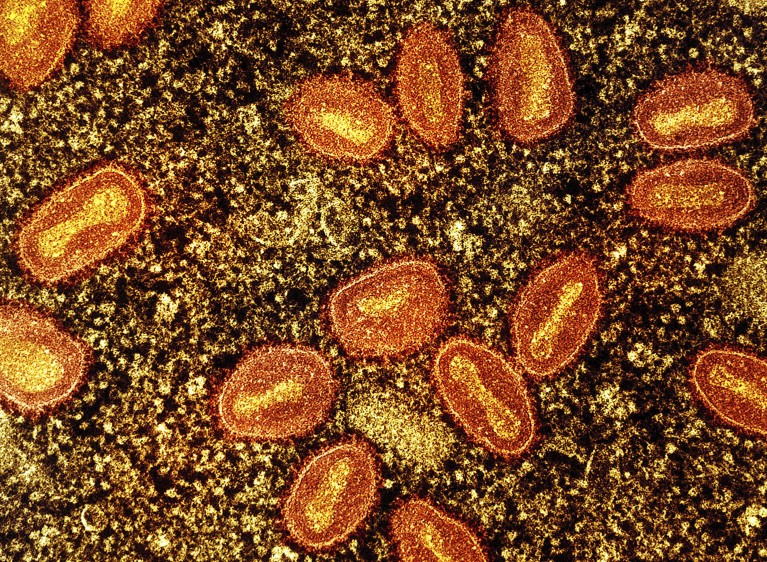
Monkeypox virus particles (shown in this coloured electron micrograph) can spread through close contact with people and animals. Credit: NIAID/Science Photo Library
When the World Health Organization (WHO) declared a public-health emergency over mpox earlier this month , it was because a concerning form of the virus that causes the disease had spread to multiple African countries where it had never been seen before. Since then, two people travelling to Africa — one from Sweden and one from Thailand — have become infected with that type of virus, called clade Ib, and brought it back to their countries.

Monkeypox virus: dangerous strain gains ability to spread through sex, new data suggest
Although researchers have known about the current outbreak since late last year, the need for answers about it is now more pressing than ever. The Democratic Republic of the Congo (DRC) has spent decades grappling with monkeypox clade I virus — the lineage to which Ib belongs. But in the past, clade I infections usually arose when a person came into contact with wild animals, and outbreaks would fizzle out.
Clade Ib seems to be different, and is spreading largely through contact between humans, including through sex . Around 18,000 suspected cases of mpox, many of them among children, and at least 600 deaths potentially attributable to the disease have been reported this year in the DRC alone.
How does this emergency compare with one declared in 2022, when mpox cases spread around the globe? How is this virus behaving compared with the version that triggered that outbreak, a type called clade II? And will Africa be able to rein this one in? Nature talks to researchers about information they are rushing to gather.
Is clade Ib more deadly than the other virus types?
It’s hard to determine, says Jason Kindrachuk, a virologist at the University of Manitoba in Winnipeg, Canada. He says that the DRC is experiencing two outbreaks simultaneously. The clade I virus, which has been endemic in forested regions of the DRC for decades, circulates in rural regions, where people get it from animals. That clade was renamed Ia after the discovery of clade Ib. Studies in animals suggest that clade I is deadlier than clade II 1 — but Kindrachuk says that it’s hard to speculate on what that means for humans at this point.
Even when not fatal, mpox can trigger fevers, aches and painful fluid-filled skin lesions.
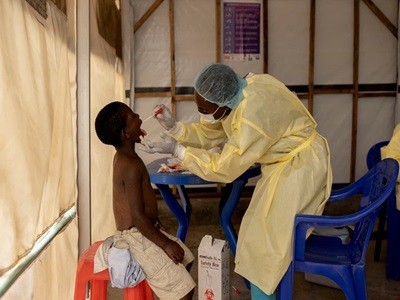
Growing mpox outbreak prompts WHO to declare global health emergency
Although many reports state that 10% of clade I infections in humans are fatal, infectious-disease researcher Laurens Liesenborghs at the Institute of Tropical Medicine in Antwerp, Belgium, doubts that this figure is accurate. Even the WHO’s latest estimate of a 3.5% fatality rate for people with mpox in the DRC might be high.
There are many reasons that fatality estimates might be unreliable, Liesenborghs says. For one, surveillance data capture only the most severe cases; many people who are less ill might not seek care at hospitals or through physicians, so their infections go unreported.
Another factor that can confound fatality rates is a secondary health condition. For example, people living with HIV — who can represent a large proportion of the population in many African countries — die from mpox at twice the rate of the general population 2 , especially if their HIV is untreated. And the relatively high death rate among children under age 5 could be partly because of malnutrition, which is common among kids in rural parts of the DRC, Liesenborghs says.
Is clade Ib more transmissible than other types?
The clade Ib virus has garnered particular attention because epidemiological data suggest that it transmits more readily between people than previous strains did, including through sexual activity, whereas clade Ia mostly comes from animals. An analysis posted ahead of peer review on the preprint server medRxiv 3 shows that clade Ib’s genome contains genetic mutations that seem to have been induced by the human immune system, suggesting that it has been in humans for some time. Clade Ia genomes have fewer of these mutations.
But Liesenborghs says that the mutations and clades might not be the most important factor in understanding how monkeypox virus spreads. Although distinguishing Ia from Ib is useful in tracking the disease, he says, the severity and transmissibility of the disease could be affected more by the region where the virus is circulating and the people there. Clade Ia, for instance, seems to be more common in sparsely populated rural regions where it is less likely to spread far. Clade Ib is cropping up in densely populated areas and spreading more readily.
Jean Nachega, an infectious-disease physician at the University of Pittsburgh in Pennsylvania, says that scientists don’t understand many aspects of mpox transmission — they haven’t even determined which animal serves as a reservoir for the virus in the wild, although rodents are able to carry it. “We have to be very humble,” Nachega says.
How effective are vaccines against the clade I virus?
Just as was the case during the COVID-19 pandemic, health experts are looking to vaccines to help curb this mpox outbreak. Although there are no vaccines designed specifically against the monkeypox virus, there are two vaccines proven to ward off a related poxvirus — the one that causes smallpox. Jynneos, made by biotechnology company Bavarian Nordic in Hellerup, Denmark, contains a type of poxvirus that can’t replicate but can trigger an immune response. LC16m8, made by pharmaceutical company KM Biologics in Kumamoto, Japan, contains a live — but weakened — version of a different poxvirus strain.
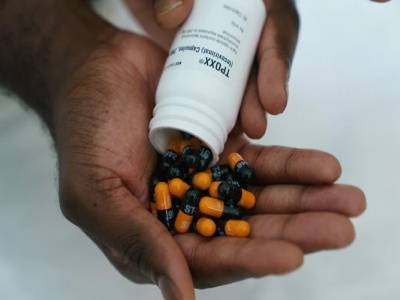
Hopes dashed for drug aimed at monkeypox virus spreading in Africa
Still, it’s unclear how effective these smallpox vaccines are against mpox generally. Dimie Ogoina, an infectious-disease specialist at Niger Delta University in Wilberforce Island, Nigeria, points out that vaccines have been tested only against clade II virus in European and US populations, because these shots were distributed by wealthy nations during the 2022 global outbreak . And those recipients were primarily young, healthy men who have sex with men, a population that was particularly susceptible during that outbreak. One study in the United States found that one dose of Jynneos was 80% effective at preventing the disease in at-risk people, whereas two doses were 82% effective 4 ; the WHO recommends getting both jabs.
People in Africa infected with either the clade Ia or Ib virus — especially children and those with compromised immune systems — might respond differently. However, one study in the DRC found that the Jynneos vaccine generally raised antibodies against mpox in about 1,000 health-care workers who received it 5 .
But researchers are trying to fill in some data gaps. A team in the DRC is about to launch a clinical trial of Jynneos in people who have come into close contact with the monkeypox virus — but have not shown symptoms — to see whether it can prevent future infection, or improve outcomes if an infection arises.
Will the vaccines help to rein in the latest outbreak?
Mpox vaccines have been largely unavailable in Africa, but several wealthy countries have pledged to donate doses to the DRC and other affected African nations. The United States has offered 50,000 Jynneos doses from its national stockpile, and the European Union has ordered 175,000, with individual member countries pledging extra doses. Bavarian Nordic has also added another 40,000. Japan has offered 3.5 million doses of LC16m8 — for which only one jab is recommended instead of two.
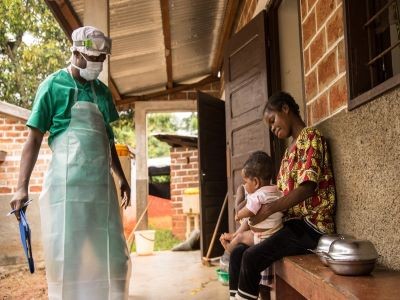
Monkeypox in Africa: the science the world ignored
None of them have arrived yet, though, says Espoir Bwenge Malembaka, an epidemiologist at the Catholic University of Bukavu in the DRC. Low- and middle-income nations cannot receive vaccines until the WHO has deemed the jabs safe and effective. And the WHO has not given its thumbs up yet. It is evaluating data from vaccine manufacturers, delaying donors’ ability to send the vaccines.
Even when the vaccines arrive, Bwenge Malembaka says, “it’s really a drop in the bucket”. The Africa Centres for Disease Control and Prevention in Addis Ababa, Ethiopia, estimates that 10 million doses are needed to rein in the outbreak.
Bwenge Malembaka says that the uncertainty over vaccine arrival has made it difficult for the government to form a distribution plan. “I don’t know how one can go about this kind of challenge,” he says. Bwenge Malembaka suspects that children are likely to receive doses first, because they are highly vulnerable to clade I, but officials haven’t decided which regions to target. It’s also unclear how the government would prioritize other vulnerable populations such as sex workers, who have been affected by clade Ib. Their profession is criminalized in the DRC, so they might not be able to come forward for treatment.
Researchers lament that public-health organizations didn’t provide vaccines and other resources as soon as the clade I outbreak was identified, especially given lessons learnt from the 2022 global mpox outbreak. “The opportunity was there a couple months ago to cut this transmission chain, but resources weren’t available,” Liesenborghs says. “Now, it will be more challenging to tackle this outbreak, and the population at risk is much broader.”
Nature 633 , 16-17 (2024)
doi: https://doi.org/10.1038/d41586-024-02793-9
Americo, J. L., Earl, P. L. & Moss, B. Proc. Natl Acad. Sci. USA 120 , e2220415120 (2023).
Article PubMed Google Scholar
Yinka-Ogunleye, A. et al. BMJ Glob. Health 8 , e013126 (2023).
Kinganda-Lusamaki, E. et al. Preprint at medRxiv https://doi.org/10.1101/2024.08.13.24311951 (2024).
Yeganeh, N. et al. Vaccine 42 , 125987 (2024).
Priyamvada, L. et al. Vaccine 40 , 7321–7327 (2022).
Download references
Reprints and permissions
Related Articles

- Public health

Mapping glycoprotein structure reveals Flaviviridae evolutionary history
Article 04 SEP 24

Farmed fur animals harbour viruses with zoonotic spillover potential

Mysterious Oropouche virus is spreading: what you should know
News Q&A 26 AUG 24

Found: a brain-wiring pattern linked to depression
News 04 SEP 24

The hepatitis C virus envelope protein complex is a dimer of heterodimers

How rival weight-loss drugs fare at treating obesity, diabetes and more
News 03 SEP 24

What accelerates brain ageing? This AI ‘brain clock’ points to answers
News 27 AUG 24

Extreme heat is a huge killer — these local approaches can keep people safe
News 22 AUG 24
Faculty Recruitment, Westlake University School of Medicine
Faculty positions are open at four distinct ranks: Assistant Professor, Associate Professor, Full Professor, and Chair Professor.
Hangzhou, Zhejiang, China
Westlake University
Postdoctoral Researcher - Neural Circuits Genetics and Physiology for Learning and Memory
A postdoctoral position is available to study molecular mechanisms, neural circuits and neurophysiology of learning and memory.
Dallas, Texas (US)
The University of Texas Southwestern Medical Center
Assistant/Associate Professor (Tenure Track) - Integrative Biology & Pharmacology
The Department of Integrative Biology and Pharmacology (https://med.uth.edu/ibp/), McGovern Medical School at The University of Texas Health Scienc...
Houston, Texas (US)
UTHealth Houston
Faculty Positions
The Yale Stem Cell Center invites applications for faculty positions at the rank of Assistant, Associate, or full Professor. Rank and tenure will b...
New Haven, Connecticut
Yale Stem Cell Center
Postdoc/PhD opportunity – Pharmacology of Opioids
Join us at MedUni Vienna to explore the pharmacology of circular and stapled peptide therapeutics targetting the κ-opioid receptor in the periphery.
Vienna (AT)
Medical University of Vienna
Sign up for the Nature Briefing newsletter — what matters in science, free to your inbox daily.
Quick links
- Explore articles by subject
- Guide to authors
- Editorial policies
- Open access
- Published: 04 September 2024
A serological survey of COVID-19 among predominantly aboriginal residents of a tourist island in southern Thailand
- Supakorn Sripaew 1 , 2 ,
- Kameelah Yasharad 3 ,
- Dzerlina S. Rahari 1 ,
- Weiyan Feng 1 ,
- Zhenzhu Qian 1 ,
- Huynh Ngoc Thanh 1 ,
- Agus Fitriangga 1 ,
- Satiti Palupi Purwanto 1 ,
- Aye Nyein Phyu 1 ,
- Fangming Xianyu 1 ,
- Sombat Phadungvitvatthana 4 ,
- Wit Wichaidit 1 ,
- Ponlagrit Kumwichar 1 &
- Virasakdi Chongsuvivatwong ORCID: orcid.org/0000-0002-9850-4463 1
Tropical Medicine and Health volume 52 , Article number: 57 ( 2024 ) Cite this article
Metrics details
The current survey describes the seroprevalence, history of coronavirus disease 2019 (COVID-19), and vaccination status among predominantly aboriginal residents on a tourist island in southern Thailand. This information can be translated into COVID-19 vaccination and control plans for this population.
We implemented questionnaire interviews and collected blood samples from 249 residents of Lipe Island, Satun Province, in January 2022. We measured the anti-nucleocapsid protein and anti-spike (anti-S) receptor-binding protein levels of immunoglobulin (Ig) M and IgG. The differences in antibody levels among participants with different histories of vaccination and infection were analyzed using one-way analysis of variance with multiple comparisons.
During the 2-year pandemic period, no island residents with COVID-19 required hospitalization despite the high prevalence of hypertension (33.3%) and diabetes mellitus (21.7%). Approximately 18.8% of the participants reported a history of COVID-19 diagnosis. In total, 95.1% of the participants had a history of complete vaccination, of which 93.5% were seropositive. The anti-S IgG geometric means (geometric standard deviation) were 3945.8 (2.0), 829.8 (9.7) AU/mL, 789.9 (5.3) AU/mL, and 22.7 (7.1) AU/mL, respectively, in participants with a history of both COVID-19 diagnosis and complete vaccination (group 1), incomplete vaccination and subsequent COVID-19 diagnosis (group 2), complete vaccination but no previous infection (group 3), or neither previous COVID-19 and complete vaccination (group 4). Significant pairwise differences in anti-S IgG levels were found between certain groups (1 vs 3, 1 vs 4, 2 vs 4, and 3 vs 4).
Conclusions
The high coverage of vaccination, high levels of population antibody titers, variable antibody levels among completely vaccinated non-infected residents, and high prevalence of non-communicable diseases (NCDs) suggested that the local health systems could control the pandemic. However, continuing surveillance, booster vaccinations, and NCD prevention programs were still required.
Thailand, a middle-income country in Southeast Asia, was the second country to report a case of coronavirus disease 2019 (COVID-19) in January 2020 [ 1 ]. The southern region of the country is particularly affected, as tourism is the main source of income in the region. Lipe Island, located in the Andaman Sea off the coast of Satun Province, is a world-famous beach and diving destination with a population of approximately 1300 people, mostly belonging to the Urak Lawoi ( Chao Lay / Orang Laut ) indigenous group, who traditionally earned their living as fishermen [ 2 ], but abandoned their subsistence economy lifestyle with the onset of tourism. The men work as boat drivers, while the women are homemakers [ 3 ]. These adaptations introduced susceptibility to non-communicable diseases (NCDs), similar to indigenous peoples elsewhere [ 4 ]. Furthermore, these adaptations and the increase in NCDs also made the population more susceptible to COVID-19 diagnosis [ 5 ] and mortality compared to those with more resources [ 6 ].
The Urak Lawoi are indigenous people who have inhabited islands in the Andaman Sea for hundreds of years [ 7 ] and can be considered part of the larger population of over 370 million indigenous persons, constituting approximately six percent of the world population [ 8 ]. During the COVID-19 pandemic, the burden of disease among indigenous people was exacerbated by their social and economic vulnerabilities, including income loss and high density of household members, which in turn resulted in poorer health outcomes compared to non-indigenous people [ 9 , 10 ]. According to previous reports [ 11 , 12 , 13 ], extremely overcrowded housing was reported in Māori (New Zealand), Aboriginal and Torres Strait Islander (Australia), and Métis and Inuit (Canada) populations, which could make indigenous populations more prone to COVID-19 transmission [ 11 ]. In addition, limited healthcare access during the pandemic further exacerbates the burden of COVID-19 among indigenous people [ 9 ]. Even though public health authorities have made substantial efforts in vaccination programs, the lack of well-organized surveillance and reporting systems in indigenous communities presents gaps in COVID-19 control [ 9 , 14 , 15 , 16 ].
In Thailand, COVID-19 vaccine roll-out had commenced in early 2021. In the first half of the year, three vaccines were first imported and distributed to the general population, including Lipe residents: a recombinant, replication-deficient chimpanzee adenovirus (ChAdOx1), an inactivated SARS-CoV-2 antigen (CZ02 strain), and an inactivated SARS-CoV-2 antigen (Tan-HB02 strain). With the continuous emergence of new SARS-CoV-2 strains, an mRNA encoding the viral spike protein of SARS-CoV-2 (Omicron XBB.1.5) was approved by the Food and Drug Administration in August 2021, and became one of the ministry-recommended vaccines [ 17 , 18 ].
The first case of COVID-19 on Lipe Island was detected in June 2021, coinciding with the commencement of vaccination efforts by local health authorities. In August 2021, the incidence of COVID-19 in the island peaked, prompting the government to impose travel restrictions. After the island’s closure, the health authorities continued their efforts to vaccinate the island residents according to the ministry policy. In November 2021, the latest vaccine (ChAdOx1) batch was distributed to the residents, and approximately 90% of the population was reportedly vaccinated with at least two doses of either inactivated viral antigen, viral vector, or mRNA vaccines.
Transmission of COVID-19 in a community depends on the level of immunity in the population, which is determined by the depletion and repletion of susceptible individuals [ 19 ]. However, COVID-19 diagnoses are often asymptomatic [ 20 ], which undermines assessment based solely on reported cases and vaccination data. Furthermore, immunity levels may change over time after natural acquisition (i.e., infection) or vaccination, further complicating the assessment. Previous studies in Thailand had been conducted only among the general population and health care providers [ 21 , 22 ] There was no baseline data on immunity levels for the local residents of Lipe Island, who are predominantly Urak Lawoi [ 23 ].
Owing to the importance of Lipe Island tourism to Satun’s economy, the local public health office has been under great pressure from residents, business owners, and the national government to reopen the island to tourism. However, such decisions must be balanced against the potential impact on the health of the island’s residents, particularly the Urak Lawoi people. A seroprevalence survey of the local population combined with self-reported information on COVID-19 vaccination and infection history can yield objective empirical data to support this important decision. The findings from such surveys can inform decision-makers regarding the level of immunity/vulnerability of the residents and also help in planning the future course of action to prevent and control the pandemic. Therefore, this study aimed to describe the seroprevalence and levels of antibodies against COVID-19 among the predominantly aboriginal Urak Lawoi residents of Lipe Island, Satun Province, southern Thailand.
Study design and setting
We conducted a cross-sectional study that included a questionnaire interview and serological survey of Lipe Island between January 14 and 16, 2022, after the pandemic in the country started to subside. The island has an area of 1.5 km [ 2 ], a population of approximately 1300, and a health center where primary care, including vaccination, is provided. During the COVID-19 outbreak, a system was established to isolate infected patients and quarantine individuals in close contact. Local hotels and schools on the island were used for such isolation. If patients needed urgent or emergent care, they were transferred to the mainland hospital by speedboat; however, no severe cases were detected. A recent health region survey over seven provinces adjacent to Satun province, where the current survey was conducted, showed that B.1.1.529 (Omicron) was the most common variant in the region, accounting for 56.4% of the 3215 randomly selected samples. Due to the island’s closure, the island vaccination program was scheduled by the Department of Disease Control and Prevention, Health Region 11, Ministry of Public Health, to immunize the residents as early as in the early phase of the epidemic. According to the policy [ 17 , 18 ], only certain vaccines were available at the time: (1) ChAdOx1 viral vector vaccine, (2) CZ02 strain inactivated vaccine, (3) Tan-HB02 strain inactivated vaccine and (4) mRNA (Omicron XBB.1.5) vaccine, of which their administrations were scheduled based on the national batch-of-vaccine-supply policy.
Study population and selection of study participants
The study population included all residents of Lipe Island who were listed in the local health office registry. The inclusion criteria were as follows: (1) age 18 years or older and (2) ability to communicate in Thai, Malay, English, or Burmese.
We calculated the sample size based on the assumption that the prevalence was 83.0%, with a limit of 95% ± 5.0% from the estimate. A total of 217 respondents were required to address the study’s objectives.
To select our study participants, we requested a population registry of the island from a local public health office. We then used a spreadsheet to select the required number of eligible participants using simple random sampling and informed the health office of the list of sampled residents. The health office then coordinated with the local health center to contact the sampled residents and invite them to the data collection session at a designated time and place.
Data collection and serological testing
After a pilot study in a similar coastal community, questionnaire interviews were conducted by Thai graduate students, one faculty member, and six research assistants after obtaining written informed consent. Data were directly entered into a server using a web-based application (KoboToolbox, available at Kobotoolbox.org). Investigators then exported the entered data, which contained demographic and health characteristics (age, sex, education, occupation, income, household size, smoking status, and medical conditions), vaccination status, history of COVID-19 diagnosis, and the participant identification number to a spreadsheet file.
After the interview, licensed medical technologists and two registered nurses collected cubital venous blood from participants who consented to the blood draw. Investigators separated whole blood from each participant into three aliquots and stored the aliquots at 3–5 °C at a nearby community health center. Medical technologists then transported all refrigerated blood samples to the Office for Disease Prevention and Control Region 12 within 72 h after collection, where antibody levels were measured. The technologists were blinded to the interview data, and the serological test results were exported to another spreadsheet file with the project identification numbers.
We used anti-spike receptor-binding protein (anti-S RBD) and anti-nucleocapsid protein (anti-N) to describe serological characteristics of the island residents. Anti-S test can aid the evaluation of individual immune status (its positivity) or monitoring antibody response (its quantity) after infection or vaccination. Anti-N was selected as a supplement for the anti-S test as it provides additional information about the plausibility of previous exposure to inactivated vaccines or previous COVID-19 infections rather than exposure to other vaccine types. [ 24 ] Thus it could help distinguish between infection or vaccination exposure in seropositive individuals. According to the national guideline on COVID-19 vaccination for the situation in 2021, complete vaccination was defined as status of having vaccinated with at least two doses of any vaccines.
Laboratory scientists quantified anti-S immunoglobulin G (IgG) levels in arbitrary units (AU/mL) and assessed the positivity of anti-S IgM (Architect i2000SR System, Abbott Laboratories Abbott Park, Illinois, United States) and IgG (SEMI-QUANT for use with Architect, Abbott Laboratories Abbott Park, Illinois, United States) using the chemiluminescent microparticle immunoassay technique. Anti-N IgM and IgG positivity were assessed using the EUROIMMUN ELISA test (PerkinElmer Waltham, Massachusetts, United States). IgM positivity indicates recent exposure to the antigen, and IgG positivity indicates past exposure. All the tests were claimed to be sensitive to detect antibodies developed after the exposure of any circulating severe acute respiratory syndrome coronavirus 2 (SARS-CoV-2) variants at the time. Anti-S IgG levels stabilize 6 months after SARS-CoV-2 infection [ 25 ], while anti-N IgG levels significantly decline 6 months post-infection [ 26 ]. After receiving the laboratory results, members of the data collection team reported the laboratory findings to consenting participants.
Statistical analysis
After data cleaning, we merged the interview data with the laboratory results based on the project identification numbers. We used descriptive statistics to summarize the characteristics of the study participants and serological test results in each subgroup. Hypothesis testing between two categorical variables was performed using the Chi-square or Fisher’s exact test. For continuous variables, such as log-transformed antibody titers, one-way analysis of variance (ANOVA) was performed with a significance level set at < 0.05. For variables with statistically significant ANOVA test results, post hoc (Bonferroni) tests were performed to compare all pairs of transformed means with multiple comparison adjustments. R software version 4.1.0, with epicalc, lubridate, stringr, and ggplot2 packages, was used for all analyses.
Among 283 eligible participants, 249 participated in the interviews. Among the participants, four refused to undergo blood tests; thus, seroprevalence data were available for 245 participants, and 93.5% were seropositive (Table 1 ). Sixteen participants were seronegative, suggesting they had been neither infected nor vaccinated. Overall, 97.7% and 41.1% of seropositive individuals had anti-S and anti-N positive (including borderline results), respectively. IgM positivity was relatively low in the study participants (3.7% and 12.3% for anti-N IgM and anti-S IgM, respectively) compared with positive IgG status (31.7% and 93.4% for anti-N IgG and anti-S IgG, respectively). Among those who were seropositive, the majority had only IgG against the spike protein, which indicated that they were vaccinated with either the mRNA or viral vector vaccine, rather than vaccinated with inactivated vaccines or had previous COVID-19 infections. The second most common positive group had positive IgG against both spike and nucleocapsid proteins. This group could have been exposed to either an inactivated virus vaccine or natural infection, with or without vaccination.
The majority of the participants had less than a high school education and were unemployed or worked in class 1 occupations (laborer, agriculture or fishery) (Table 2 ). However, compared to seropositive participants, seronegative participants included a higher proportion of older persons, males, smokers, low-income persons, and those who never traveled to the mainland since the start of the COVID-19 pandemic. The majority of participants were Thai; there were only three non-Thai nationalities, two of whom were Burmese, and one of them was American. Approximately half of the participants had a history of at least one of the following diseases: hypertension (33.3%), hyperlipidemia (25.7%), diabetes mellitus (21.7%), asthma (6.4%), or chronic kidney diseases (3.2%). However, seronegative participants also had a higher prevalence of chronic disease compared to seropositive participants.
Table 3 describes vaccination regimen among the study participants ( n = 243). Most participants received complete vaccination. Only seven and four participants were not vaccinated and vaccinated with only one vaccine, respectively. The most common type of vaccine regimen was an alternate regimen involving an inactivated vaccine (CZ02 strain) and a viral vector vaccine (ChAdOx1) (25.5%). Only two participants had received the mRNA vaccine as their third dose. Among the vaccinated persons, the longest approximated time since the last vaccination was 31 weeks (4.5%), while most of the participants were vaccinated 3–6 months prior to the serological testing. Considering potential anti-N seropositivity, approximately half and one-fifth of the participants were vaccinated with inactivated vaccines (A or B) longer than and within the previous 6 months, respectively.
Within a 2-year period since the beginning of the pandemic, with 18.7% of the island residents diagnosed with COVID-19, there had not been any hospitalized patients. Participants with two or more vaccine doses were more likely to be seropositive (Table 4 ). Universal seropositivity was generally found among those with two or more vaccine doses, except for participants with no history of COVID-19 diagnosis or close contact with COVID-19 cases. A minority group (approximately 10%) was seronegative. All participants who received the three doses of vaccination were seropositive.
A plot of the log-transformed anti-S receptor-binding domain IgG titer versus the history of COVID-19 diagnosis and vaccination status (incomplete vs. complete) showed significant differences in titer levels between groups, except for the differences between Groups 1 and 2 and between Groups 2 and 3 (Fig. 1 ). Calculation of geometric means showed that those with a history of COVID-19 diagnosis and complete vaccination had the highest geometric mean level of anti-S IgG titer, and those with no history of COVID-19 diagnosis and incomplete vaccination had the lowest geometric mean level (Table 5 ).

Distribution of anti-spike receptor-binding domain IgG titer (in natural logarithmic scale) by history of COVID-19 diagnosis and vaccination status. Group 1: history of COVID-19 diagnosis, complete vaccination; Group 2: history of COVID-19 diagnosis, incomplete vaccination; Group 3: no history of COVID-19 diagnosis, complete vaccination; Group 4: no history of COVID-19 diagnosis, incomplete vaccination, thick dot and whiskers denote group mean ± SD. *** Denotes significant difference between groups with p < 0.001
Figure 2 illustrates levels of log-transformed anti-S IgG stratified by anti-N IgM and IgG. The group of participants who reported previous COVID-19 diagnosis, with most participants completely vaccinated (89.1%), had relatively higher anti-S IgG levels than the other groups. Almost all members of the group with negative anti-N antibodies had complete vaccination but did not report previous infection (group 3). These participants had higher variability of anti-S IgG than the other groups. A higher proportion of participants with a history of COVID-19 diagnosis had positive anti-N IgM (33.3%) and positive anti-N IgG (39.0%) than other anti-N statuses (9.8%).
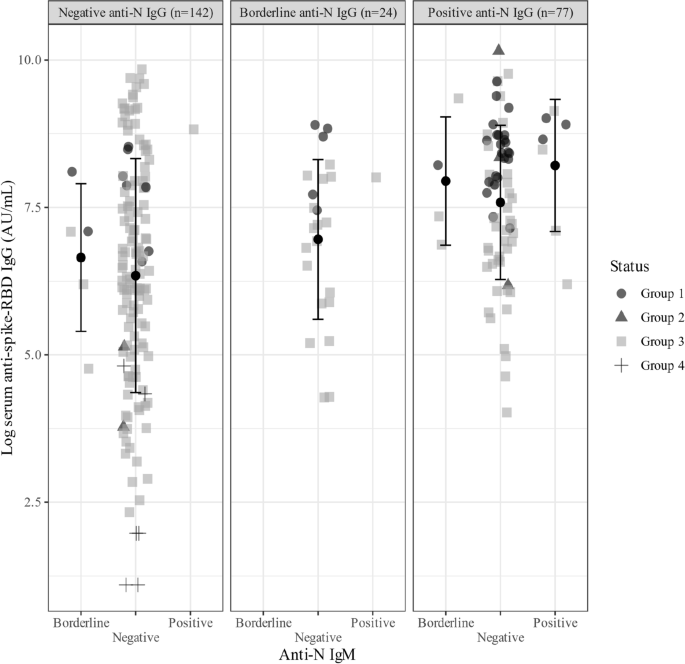
Distribution of anti-spike receptor-binding domain IgG titer (in natural logarithmic scale) by anti-nucleocapsid protein (IgM and IgG), history of COVID-19 diagnosis, and vaccination status. Group 1: history of COVID-19 diagnosis, complete vaccination; Group 2: history of COVID-19 diagnosis, incomplete vaccination; Group 3: no history of COVID-19 diagnosis, complete vaccination; Group 4: no history of COVID-19 diagnosis, incomplete vaccination, thick dot and whiskers denote group mean ± SD
We conducted a seroprevalence survey combined with interviews of residents (most of whom are indigenous people) of Lipe Island, a tourist destination in southern Thailand. We found a relatively high prevalence of NCDs among study participants. The majority of the participants also reported receiving two or three doses of the COVID-19 vaccine, whereas a history of COVID-19 diagnosis was relatively uncommon. Anti-S IgG was found in approximately nine-tenths of the participants, half of whom did not have anti-N IgG. Seropositivity was strongly associated with the receipt of two COVID-19 vaccine doses. The findings also showed that participants who had a history of COVID-19 diagnosis were more likely to have positive anti-N IgM and IgG than the non-infected persons. Apart from that, a relatively more variable anti-S IgG level was found in the group where residents were completely vaccinated and non-infected.
The current serological survey took place while the second wave of COVID-19 on the island was subsiding. The island vaccination program had been deployed for approximately 2 months, and almost all island residents had been vaccinated. The overall seroprevalence in this study was remarkably higher than that in other larger islands demonstrated in previous studies. A bigger island (with approximately fifty thousand inhabitants) in Denmark [ 27 ] had remarkably smaller seroprevalence (93.5% versus 0.7%) at the beginning of the pandemic (April 27–May 1, 2020) when vaccines were still under development. In another comparably populated and partially vaccinated (42% and 10% having received at least 2 doses inactivated SARS-CoV-2 and ChAdOx1 vaccine, respectively, of which their last dose was approximately 7 weeks prior to the serological testing) island (3612 residents) in Brazil, where a serological survey took place at approximately 5 months after the vaccine roll-out, the seropositive rate was 53.6% [ 28 ]. However, our dose–response relationship in seroprevalence across vaccination-infection groups was consistent with that in a study from Cyprus conducted in the second half of 2021 when the national vaccination program had been deployed for 6 months, and 54.2% of the participants were vaccinated [ 29 ]. The anti-spike-receptor binding domain (RBD) IgG levels among individuals who were not vaccinated and had never been diagnosed with COVID-19 were significantly lower than those in the other groups. Nevertheless, the levels of the IgG in the current study were almost at one-fifth of that of the Cyprians. According to previous studies [ 30 , 31 ], anti-spike-RBD IgG levels peak approximately 4 weeks after the second injection (i.e., complete vaccination) and significantly decline at 3–6 months after vaccination to levels comparable with those in individuals with immunity acquired from natural infection. Thus, the antibody levels suggested that residents with complete vaccination were recently vaccinated.
The current study found that approximately 4% of seropositive individuals were anti-nucleocapsid protein IgM positive, and a history of COVID-19 diagnosis was relatively common in the participants who had positive anti-N IgM and anti-N IgG than in the other groups. Accordingly, a recent COVID diagnosis, which was likely represented by anti-N positivity [ 32 ], might have been relatively small in the sample. In addition, we found that the overall seropositivity was positively associated with vaccination rather than a history of COVID-19 diagnosis, with a clear dose–response relationship. Similar results were also found abroad and in a study based in Thailand [ 31 , 33 ]. Further, we found that almost all the persons who had antibodies against spike protein were likely persons who had completed vaccination rather than persons who had COVID-19 diagnosis. Therefore, we assessed that the seropositivity and anti-S antibody mainly represented high vaccination coverage. The 95.1% prevalence of complete vaccination in this study was higher than in studies in Australia 15 and Canada 16 . The high coverage on this tourist island could be partly attributed to the strong policy of the government and the enthusiasm of the local population to maximize vaccination coverage to ensure the reopening of the country to international tourism.
According to a previous study [ 34 ], circulating anti-S-RBD and anti-N antibody were significantly correlated with the immune neutralizing activity. The second figure shows relatively higher proportions of individuals who had previous COVID-19 infection with complete vaccination (i.e., hybrid immunity) than persons who only had vaccination (without reported COVID-19 diagnoses) in a group where both anti-N IgM and/or IgG were positive (contributed approximately 29% of the sample). Our serological results combined with self-reports could supplement a previous finding of high magnitude and durability of COVID-19 protection in persons with hybrid immunity [ 35 ]. Furthermore, the anti-S level of the participants with hybrid immunity were relatively higher than that of the participants who were completely vaccinated but did not report previous COVID-19 diagnoses. This difference was also observed in another study, which also revealed that individuals who were both completely vaccinated and previously infected by SARS-CoV-2 had slower antibody decline than those who were solely vaccinated [ 36 ]. Apart from that, higher variability of anti-S IgG in persons who solely had complete vaccination than in the other groups, and variability of vaccination regimen (mainly inactivated non-Omicron SARS-CoV-2 variant vaccines while the most common variant was Omicron) highlights the importance of long-term monitoring of new infections despite high vaccination coverage in the island residents. Re-opening the island would potentially exponentiate the number of new COVID-19 cases while the existing immunity wanes [ 37 ]. Thus, we suggested that local public health authorities should consider continuing disease surveillance and organizing booster vaccination programs to maintain protection against the virus among island residents [ 38 ].
The prevalence of NCDs was higher in the study population than in the general population of Thailand [ 39 ]. Economic development, including tourism, has been shown to change the lifestyles of indigenous people, making them more prone to NCDs [ 40 ]. The local population in this study was protected from the pandemic; however, they are still highly vulnerable to the long-term effects of NCDs and decaying vaccine efficacy [ 41 ], which require different solutions from those for the pandemic. NCDs are likely to be aggravated once the tourism industry re-opens on this island. The high prevalence of NCDs, high coverage of vaccination, high levels of population antibody titers, and low levels of complications from COVID-19 suggest that the local health systems have been on target for pandemic control but not for NCDs. Control of COVID-19 should be continued in parallel with the improvement of NCD prevention.
This study was the first to assess the COVID-19 seroprevalence in a predominantly indigenous population living in a tourist resort island in Thailand. The findings provided insights into the seroprevalence and antibody profile in Aboriginal people who are biologically and socio-behaviorally susceptible to infection. Nevertheless, several limitations should be considered when interpreting our study findings. First, participants were predominantly female, with relatively few working-age participants. Caveats should be considered when generalizing the information to the population of the entire island. Second, our calculated sample size might not have yielded adequate statistical power to assess the association between seropositivity, vaccination, and history of diagnosis with COVID-19. Thus, we could not rule out chance as the best explanation for the observed findings. Lastly, we only investigated individuals’ antibody statuses, which are indirect measurements for individual protection against COVID-19; antibody levels in the study population may wane over time, and new strains of SARS-CoV-2 may emerge. Thus, the high seroprevalence at the time of study may not necessarily imply full and sustained protection against future SARS-CoV-2 infections.
We observed high seroprevalence rates, likely attributable to the vaccination program, alongside a low incidence of COVID-19 cases during the outbreak on Lipe Island. However, antibody levels among the completely vaccinated residents without a history of COVID-19 varied, and there was a comparably high prevalence of chronic diseases among the residents. This serological survey can help explain the relatively low level of COVID-19 health burden in this population and guide control policy. This approach can be applied to similar populations.
Availability of data and materials
Fully de-identified data are available upon written request to the corresponding author.
Abbreviations
Anti-spike receptor-binding protein
Anti-nucleocapsid protein
Non-communicable disease
World Bank. Monitoring the impact of COVID-19 in Thailand; 2021. https://www.worldbank.org/en/country/thailand/publication/monitoring-the-impact-of-covid-19-in-thailand , Accessed 18 Nov 2022.
De Groot JY. Migration, community forming and language change among the Urak Lawoi’ of Thailand’s Andaman Coast. Prince Songkla Univ J Int Stud. 2012;2:93–116.
Google Scholar
Khammaneechan P. Health need assessment of ethnic group in Lipe Island, Satun Province, Thailand, 29 November. In: 1st Mae Fah Luang University International Conference, Chiang Rai, Thailand; 2012:paper number P-HS-17.
Singh K, Xin Y, Xiao Y, Quan J, Kim D, Nguyen TP, et al. Impact of the COVID-19 pandemic on chronic disease care in India, China, Hong Kong, Korea, and Vietnam. Asia Pac J Public Health. 2022;34:392–400. https://doi.org/10.1177/10105395211073052 .
Article PubMed PubMed Central Google Scholar
Baah FO, Teitelman AM, Riegel B. Marginalization: conceptualizing patient vulnerabilities in the framework of social determinants of health—an integrative review. Nurs Inq. 2019;26: e12268. https://doi.org/10.1111/nin.12268 .
Article PubMed Google Scholar
Riou J, Panczak R, Althaus CL, Junker C, Perisa D, Schneider K, et al. Socioeconomic position and the COVID-19 care cascade from testing to mortality in Switzerland: a population-based analysis. Lancet Public Health. 2021;6:e683–91. https://doi.org/10.1016/S2468-2667(21)00160-2 .
Granbom L, Lawoi U. A field study of an Indigenous people in Thailand and their problems with rapid tourist development. Sociologiska Institutionen: Lunds Universitet ; 2005. (Working Paper in Social Anthropology).
The United Nations. Indigenous peoples, indigenous voices; 2022. https://www.un.org/esa/socdev/unpfii/documents/5session_factsheet1.pdf , Accessed 30 Nov 2022.
Power T, Wilson D, Best O, Brockie T, Bourque Bearskin L, Millender E, et al. COVID-19 and Indigenous peoples: an imperative for action. J Clin Nurs. 2020;29:2737–41. https://doi.org/10.1111/jocn.15320 .
Huyser KR, Yellow Horse AJ, Collins KA, Fischer J, Jessome MG, Ronayne ET, et al. Understanding the associations among social vulnerabilities, Indigenous peoples, and COVID-19 cases within Canadian health regions. Int J Environ Res Public Health. 2022;19:12409. https://doi.org/10.3390/ijerph191912409 .
McLeod M, Gurney J, Harris R, Cormack D, King P. COVID-19: we must not forget about Indigenous health and equity. Aust N Z J Public Health. 2020;44:253–6. https://doi.org/10.1111/1753-6405.13015 .
Australian Institute of Health and Welfare. Housing circumstances of Indigenous households: Tenure and overcrowding, summary; 2022. https://www.aihw.gov.au/reports/indigenous-australians/housing-circumstances-of-indigenous-households/summary , Accessed 30 Nov 2022.
Government of Canada. Housing conditions among First Nations people, Métis and Inuit in Canada from the 2021 Census; 2022. https://www12.statcan.gc.ca/census-recensement/2021/as-sa/98-200-X/2021007/98-200-X2021007-eng.cfm , Accessed 30 Nov 2022.
Kaholokula JK, Samoa RA, Miyamoto RES, Palafox N, Daniels SA. COVID-19 special column: COVID-19 hits native Hawaiian and Pacific Islander communities the hardest. Hawaii J Health Soc Welf. 2020;79:144–6.
PubMed PubMed Central Google Scholar
Australian government department of health and aged care. COVID-19 vaccination—Geographic vaccination rates—SA4 Indigenous population; 2022. https://www.health.gov.au/resources/publications/covid-19-vaccination-geographic-vaccination-rates-sa4-indigenous-population-25-january-2022 , Accessed 30 Nov 2022.
Government of Canada. COVID-19 vaccines and Indigenous peoples; 2022. https://www.sac-isc.gc.ca/eng/1606941379837/1606941507767 , Accessed 30 Nov 2022.
Food and Drug Administration of Thailand. Summary Product Characteristic (SPC): COVID. No date. Accessed 18 May 2024. https://drug.fda.moph.go.th/vaccine/category/spc?ppp=50&page=1&kw=Covid .
Guideline for COVID-19 vaccination during the 2021 outbreak in Thailand (second revision). Department of disease control and prevention, Ministry of Public Health of Thailand; 2021. Accessed 30 Nov 2022. https://ddc.moph.go.th/vaccine-covid19/getFiles/11/1628849610213.pdf .
Metcalf CJE, Farrar J, Cutts FT, Basta NE, Graham AL, Lessler J, et al. Use of serological surveys to generate key insights into the changing global landscape of infectious disease. Lancet. 2016;388:728–30. https://doi.org/10.1016/S0140-6736(16)30164-7 .
Sah P, Fitzpatrick MC, Zimmer CF, Abdollahi E, Juden-Kelly L, Moghadas SM, et al. Asymptomatic SARS-CoV-2 infection: a systematic review and meta-analysis. Proc Natl Acad Sci U S A. 2021;118: e2109229118. https://doi.org/10.1073/pnas.2109229118 .
Article CAS PubMed PubMed Central Google Scholar
Lerdsamran H, Mungaomklang A, Iamsirithaworn S, Prasertsopon J, Wiriyarat W, Saritsiri S, et al. Seroprevalence of anti-SARS-CoV-2 antibodies in Thai adults during the first three epidemic waves. PLoS ONE. 2022;17: e0263316. https://doi.org/10.1371/journal.pone.0263316 .
Kittikraisak W, Piyaraj P, Vachiraphan A, Wongrapee T, Punjasamanvong S, Hunsawong T, et al. Sero-surveillance for SARS-CoV-2 infection among healthcare providers in four hospitals in Thailand one year after the first community outbreak. PLoS ONE. 2021;16: e0254563. https://doi.org/10.1371/journal.pone.0254563 .
Satun Provincial Health Office, Satun Province, Thailand; 2022. Accessed 10 Jan 2022. http://ssj.stno.moph.go.th/wordpress/ .
Gaeta A, Angeloni A, Napoli A, Pucci B, Cinti L, Roberto P, et al. Anti-N SARS-CoV-2 assays for evaluation of natural viral infection. J Immunol Methods. 2023;518: 113486. https://doi.org/10.1016/j.jim.2023.113486 .
Dan JM, Mateus J, Kato Y, Hastie KM, Yu ED, Faliti CE, et al. Immunological memory to SARS-CoV-2 assessed for up to 8 months after infection. Science. 2021;371:eabf4063. https://doi.org/10.1126/science.abf4063 .
Article CAS PubMed Google Scholar
Chansaenroj J, Yorsaeng R, Posuwan N, Puenpa J, Wanlapakorn N, Sudhinaraset N, et al. Long-term specific IgG response to SARS-CoV-2 nucleocapsid protein in recovered COVID-19 patients. Sci Rep. 2021;11:23216. https://doi.org/10.1038/s41598-021-02659-4 .
Petersen MS, Strøm M, Christiansen DH, Fjallsbak JP, Eliasen EH, Johansen M, et al. Seroprevalence of SARS-CoV-2–specific antibodies, Faroe Islands. Emerg Infect Dis. 2020;26:2761–3. https://doi.org/10.3201/eid2611.202736 .
Cerbino-Neto J, Peres IT, Varela MC, Brandão LGP, de Matos JA, Pinto LF, et al. Seroepidemiology of SARS-CoV-2 on a partially vaccinated island in Brazil: determinants of infection and vaccine response. Front Public Health. 2022;10:1017337. https://doi.org/10.3389/fpubh.2022.1017337 .
Papaneophytou C, Nicolaou A, Pieri M, Nicolaidou V, Galatou E, Sarigiannis Y, et al. Seroprevalence of immunoglobulin G antibodies against SARS-CoV-2 in Cyprus. PLoS ONE. 2022;17: e0269885. https://doi.org/10.1371/journal.pone.0269885 .
Wei J, Stoesser N, Matthews PC, Ayoubkhani D, Studley R, Bell I, et al. Antibody responses to SARS-CoV-2 vaccines in 45,965 adults from the general population of the United Kingdom. Nat Microbiol. 2021;6:1140–9. https://doi.org/10.1038/s41564-021-00947-3 .
Naaber P, Tserel L, Kangro K, Sepp E, Jürjenson V, Adamson A, et al. Dynamics of antibody response to BNT162b2 vaccine after six months: a longitudinal prospective study. Lancet Reg Health Eur. 2021;10: 100208. https://doi.org/10.1016/j.lanepe.2021.100208 .
Assis R, Jain A, Nakajima R, Jasinskas A, Khan S, Palma A, et al. Distinct SARS-CoV-2 antibody reactivity patterns elicited by natural infection and mRNA vaccination. npj Vaccines. 2021;6:132. https://doi.org/10.1038/s41541-021-00396-3 .
Sritipsukho P, Khawcharoenporn T, Siribumrungwong B, Damronglerd P, Suwantarat N, Satdhabudha A, et al. Comparing real-life effectiveness of various COVID-19 vaccine regimens during the delta variant-dominant pandemic: a test-negative case-control study. Emerg Microbes Infect. 2022;11:585–92. https://doi.org/10.1080/22221751.2022.2037398 .
Brochot E, Demey B, Touzé A, Belouzard S, Dubuisson J, Schmit JL, et al. Anti-spike, anti-nucleocapsid and neutralizing antibodies in SARS-CoV-2 inpatients and asymptomatic individuals. Front Microbiol. 2020. https://doi.org/10.3389/fmicb.2020.584251 .
Bobrovitz N, Ware H, Ma X, Li Z, Hosseini R, Cao C, et al. Protective effectiveness of previous SARS-CoV-2 infection and hybrid immunity against the omicron variant and severe disease: a systematic review and meta-regression. Lancet Infect Dis. 2023;23(5):556–67. https://doi.org/10.1016/S1473-3099(22)00801-5 .
Stellini R, Gianello R, Gomarasca W. Durability of anti-spike antibodies after vaccination with mRNA SARS-CoV-2 vaccine is longer in subjects with previous infection: could the booster dose be delayed? Infection. 2022;50:1573–7. https://doi.org/10.1007/s15010-022-01816-9 .
Kaleta T, Kern L, Hong SL, Hölzer M, Kochs G, Beer J, et al. Antibody escape and global spread of SARS-CoV-2 lineage A.27. Nat Commun. 2022;13:1152. https://doi.org/10.1038/s41467-022-28766-y .
Sheikh A, Kerr S, Woolhouse M, McMenamin J, Robertson C, EAVE II Collaborators. Severity of omicron variant of concern and effectiveness of vaccine boosters against symptomatic disease in Scotl and (EAVE II): a national cohort study with nested test-negative design. Lancet Infect Dis. 2022;22:959–66. https://doi.org/10.1016/S1473-3099(22)00141-4 .
Aekplakorn W, editor. The report of Thailand population health examination survey VI; 2021
Lane LG. International tourism as a threat to public health in Thailand. 2016, Accessed 30 Nov 2022. Alpenglow: Binghamton University Undergraduate Journal of Research and Creative Activity;6:26. https://orb.binghamton.edu/alpenglowjournal/vol6/iss1/10 .
Menni C, May A, Polidori L, Louca P, Wolf J, Capdevila J, et al. COVID-19 vaccine waning and effectiveness and side-effects of boosters: a prospective community study from the ZOE COVID Study. Lancet Infect Dis. 2022;22:1002–10. https://doi.org/10.1016/S1473-3099(22)00146-3 .
Download references
Acknowledgements
This study was part of fieldwork training in the International Program for Graduate Study in Epidemiology at Prince of Songkla University. We thank the Satun Provincial Health Office, Lipe Island Health Promotion Hospital, and Office of Disease Prevention and Control Region 12, Songkhla, for providing resources to support this work. We wish to thank Assistant Prof. Dr Nawamin Pinpathomrat for his expert opinion on the interpretation of immunology test results.
The Department of Epidemiology, Prince of Songkla University, funded the data collection. The laboratory costs were paid for by the regular budget of the Office of Disease Prevention and Control Region 12, Songkhla, Thailand.
Author information
Authors and affiliations.
Department of Epidemiology, Faculty of Medicine, Prince of Songkla University, Hat Yai, Songkhla, 90110, Thailand
Supakorn Sripaew, Dzerlina S. Rahari, Weiyan Feng, Zhenzhu Qian, Huynh Ngoc Thanh, Pei Li, Agus Fitriangga, Satiti Palupi Purwanto, Aye Nyein Phyu, Fangming Xianyu, Wit Wichaidit, Ponlagrit Kumwichar & Virasakdi Chongsuvivatwong
Department of Family and Preventive Medicine, Faculty of Medicine, Prince of Songkla University, Songkhla, Thailand
Supakorn Sripaew
Office of Disease Prevention and Control Region 12, Songkhla, Thailand
Kameelah Yasharad
Satun Provincial Public Health Office, Satun, Thailand
Sombat Phadungvitvatthana
You can also search for this author in PubMed Google Scholar
Contributions
VC conceptualized the study. SS and WW coordinated the operation. SS prepared the manuscript under supervision and review by VC and WW. Other authors contributed to the study design, field management and data analysis. All authors agree to be accountable for all aspects of this work.
Corresponding author
Correspondence to Virasakdi Chongsuvivatwong .
Ethics declarations
Ethics approval and consent to participate.
The study protocol was approved by the Office of Human Research Ethics Committees, Faculty of Medicine, Prince of Songkla University (REC number 64-599-18-2). Identifiable information of the study participants was encrypted during the data analysis process to protect privacy and confidentiality.
Consent for publication
Not applicable, as no identifiable or patient-level data are presented.
Informed consent
All subjects in this study gave written consent prior to participation.
Competing interests
The authors declare that there is no conflict of interest.
Additional information
Publisher's note.
Springer Nature remains neutral with regard to jurisdictional claims in published maps and institutional affiliations.
Rights and permissions
Open Access This article is licensed under a Creative Commons Attribution 4.0 International License, which permits use, sharing, adaptation, distribution and reproduction in any medium or format, as long as you give appropriate credit to the original author(s) and the source, provide a link to the Creative Commons licence, and indicate if changes were made. The images or other third party material in this article are included in the article's Creative Commons licence, unless indicated otherwise in a credit line to the material. If material is not included in the article's Creative Commons licence and your intended use is not permitted by statutory regulation or exceeds the permitted use, you will need to obtain permission directly from the copyright holder. To view a copy of this licence, visit http://creativecommons.org/licenses/by/4.0/ .
Reprints and permissions
About this article
Cite this article.
Sripaew, S., Yasharad, K., Rahari, D.S. et al. A serological survey of COVID-19 among predominantly aboriginal residents of a tourist island in southern Thailand. Trop Med Health 52 , 57 (2024). https://doi.org/10.1186/s41182-024-00617-0
Download citation
Received : 06 April 2024
Accepted : 15 July 2024
Published : 04 September 2024
DOI : https://doi.org/10.1186/s41182-024-00617-0
Share this article
Anyone you share the following link with will be able to read this content:
Sorry, a shareable link is not currently available for this article.
Provided by the Springer Nature SharedIt content-sharing initiative
- Chronic disease
- Seroprevalence
Tropical Medicine and Health
ISSN: 1349-4147
- Submission enquiries: Access here and click Contact Us
- General enquiries: [email protected]
TAT’s marketing plan 2025 to ignite ‘Amazing Thailand Grand Tourism Year’
Promoting the country's rich tourism resources in parallel with the unwavering commitment to strengthening the tourism ecosystem towards a target of 7.5 per cent growth in tourism revenue..
Bangkok, 15 July 2024 – The Tourism Authority of Thailand (TAT) has announced the “Amazing Thailand Grand Tourism Year” in its 2025 marketing plan to revitalise Thai tourism to prosperity in alignment with the government’s ‘IGNITE THAILAND’S TOURISM’ vision.
The annual TAT Strategic Direction for 2025 conference was presided over by H.E. Mr. Sermsak Pongpanit, Thailand’s Minister of Tourism and Sports. Also present were Ms. NatthriyaThaweevong, TAT’s Chairperson of the Board, officials and figures from the Thai public and private tourism sectors, and members of the media.

Ms. Thapanee Kiatphaibool, TAT Governor, said, “Recognising 2025 as another challenging year, TAT will be putting our best efforts into driving demand and shaping supply to accelerate Thailand’s tourism ecosystem. Our ambition is to highlight Thai tourism’s pivotal role as a key driver of the country’s prosperity and socio-economic development while securing the kingdom’s position as a world-class tourist destination.”
Reiterating the importance of tourism for the Thai economy, TAT has set a target of no less than a 7.5 per cent increase in tourism revenue for 2025, or 1.7 times higher than Thailand’s GDP growth forecast for the year. This is based on the ‘best case scenario’ of 39 million international visitors and more than 205 million domestic trips. The international market is earmarked to achieve more than 80 per cent growth over 2024.
In 2025, “Thai Charms” and “Hidden Gem Cities” will be the highlight products to inspire more travel across the country. The ‘five must-do activities’ will be diversified, including Must Taste – Thai food, Must Try – Muay Thai, Must Buy – Thai fashion and local products, Must Seek – new destinations and new travel experiences, and Must See – Thai festivals. City marketing approach will be used to promote Hidden Gems destinations, which will become a new engine to achieve a better distribution of tourism income and even out the high seasonality factor.
For the international market, the focus is on driving growth in 23 potential markets worldwide that account for more than 80 percent of the total number and revenue from foreign tourists in 2024. The aim is to increase the number of 7-digit markets to 13 markets in 2025.
TAT will continue to push for increased seat capacity in Thailand by increasing flights on current routes and adding new routes for both regular and charter flights. It will promote “Hidden Gem Cities” and “Thai Charms” that align with tourists’ needs and preferences in international markets. The strategy will also capitalise on the popularity of series, movies, and music videos filmed in Thailand among Fandoms.
For the short-haul international market, TAT has segmented visitors into New Gen and Sub-segments. Promotions will be rolled out to capture a new generation of travellers from China, Japan, South Korea, Taiwan, and Hong Kong. Meanwhile, marketing activities will be launched to drive the travel demand of the Millennials, Families, and High-Disposable Income travellers, including the shopping mania group from ASEAN, as well as self-drive and train travellers from Malaysia, Singapore, and China.
Particularly for the Chinese market, in 2025, TAT will celebrate the 50th anniversary of Thai-Chinese relations with activities at government-to-government, business-to-business, and people-to-people levels between the two countries. These include “Nihao month,” inviting world-renowned influencers and celebrities to Thailand, organising joint promotions with partners, and “Chinese Passport Special Deals” activities to stimulate travel, increase spending, and extend the stay of Chinese tourists from both major and secondary cities in China.
For long-haul Markets: Europe, Africa, the Middle East, and America, the focus will be on expanding the quality tourist market and restoring flight capacity and frequency. The strategy aims to establish new market areas and create awareness of tourism products and services.
The emphasis will be placed on expanding the quality leisure market segment, especially for first-time visitors from the UK, Ireland, Western Europe, and Western Balkan. Equally important are the new generations of travellers from the Americas and Canada, including Gen-Z, Millennials, Asian Americans, DINKs, and LGBTQs, as well as luxury travellers from the six Arab countries.
For the international market, TAT will continue to leverage the “Amazing Thailand: Your Stories Never End” communication concept to inspire visitors to become storytellers, sharing their lasting memories and motivating others to seek out their own memorable stories in Thailand.
For the domestic market, TAT will stimulate Thais to make spontaneous trips and travel more domestically through the “Create Your Great Moment Now” communication concept. Key magnets will include big events and local events, ranging from local festivals to music events and sports tournaments. In addition, activities will be rolled out to promote and enhance the value of Thai soft powers and inspire the sub-culture segment to explore local experiences in destinations across all five regions.
Northern Region invites visitors to experience the charms of the northern yesteryears that perfectly blend creativity and sustainability through food, crafts, and wellness activities.
Northeastern Region opens up to local food experiences through gastronomy tourism, and enjoy the fun of festivals and traditions that tell the story of the local way of life.
Central Region leverages the Central charms, cultural heritage, faith, and food.
Eastern Region recommends outdoor sports activities, delicious fruits, and fresh seafood.
Southern Region highlights wellcation travel and carbon-neutral tourism while immersing oneself in the nature of both coasts.
The globally recognised “Amazing Thailand” brand will be heightened in line with the goal of Thailand achieving high value and sustainable tourism growth. This will be done alongside the development of the supply chain to incorporate it into sustainable marketing processes through important projects such as TAT’s Sustainable Tourism Goals (STGs) STAR Rating System, CF-Hotels Platform, and Thailand Tourism Awards. These projects will push entrepreneurs to be more active and advance to the global sustainability stage, recognised by international awards and standards.
The year 2025 will be the Amazing Thailand Grand Tourism Year, marking a more robust era for Thai tourism. TAT would like to send a Grand Invitation to tourists worldwide to experience Thai charms and diverse products. With Grand Collaboration , visitors can expect warm hospitality from partners and locals who are eager to deliver exceptional tourism experiences. The year also promises Grand Privileges and Grand Festivities , offering happiness through celebrations and festivals. TAT encourages tourists to create Grand Moments that will leave a are meaningful, and environmentally conscious memories to be shared as future stories.
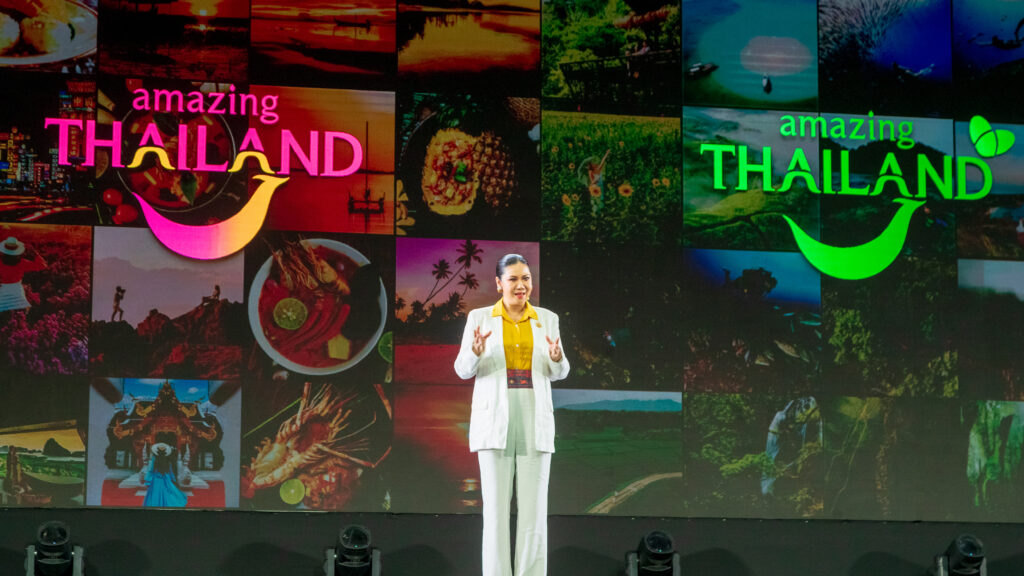
TAT Newsroom
Tat welcomes laotian tourists on full trial train from vientiane to bangkok, thailand announces longer visa stays to boost economy, related articles.

TAT strengthens Thailand’s presence at PATA Travel Mart 2024

“Amazing Muay Thai Road to Rajadamnern 2024” in Melbourne highlights Thai soft powers


COMMENTS
Mr. Pipat Ratchakitprakan, Minister of Tourism and Sport and Thailand is ready to welcome international visitors into the kingdom again, after establishing m...
The official site of Tourism Authority of Thailand. Amazing Thailand, Travel information, Travel guide, maps, hotels, accommodation, attractions, events & festivals, food, culture, shopping information to help you plan your Thailand vacations.
TourismThailand, 09 Nov 2021. Print. Share to. Keep This. The Tourism Authority of Thailand (TAT) launches the new tourism concept for 2022 " amazing thailand, Amazing New Chapters ". Thailand is now filled with more amazing new experiences than ever before. Visit Thailand in the year 2022 and make your new chapter the very best of your life.
Bangkok, 18 July, 2022 - The Tourism Authority of Thailand (TAT) has announced the marketing plan for 2023 that will continue this year's goal to revitalise and transform Thai tourism, while placing greater emphasis on the recovery of the tourism sector towards stronger and sustainable, more responsible, more digital and more inclusive tourism growth.
The Tourism Authority of Thailand (TAT) is strengthening the ongoing "Visit Thailand Year: Amazing New Chapters" campaign towards a meaningful travel direction. Underlining the kingdom's soft power foundations and experience-based tourism, key strategies include elevating supply and sustainable standards, and raising awareness among stakeholders about the importance of being hospitable ...
Thailand prepare for reopening to international touristsTourism officials hope to portray Thailand as a safe destination and the first batch of tourists will...
This professional campaign titled 'Amazing Thailand - Culture to Commerce' was published in Thailand in May, 2023. It was created for the brand: Tourism Authority of Thailand, by ad agency: Ogilvy Group Thailand. This Integrated medium campaign is related to the Recreation, Leisure and Travel and Tourism industries and contains 2 media assets.
6,592 3 minutes read. London, 02 November, 2021 - The Tourism Authority of Thailand (TAT) introduced the latest tourism marketing campaign, the 'Visit Thailand Year 2022" with a number of strategic activities to promote the reopening of the kingdom's 'Amazing New Chapters' of new normal tourism at one of the world's leading travel ...
Amazing Thailand. 2,673,039 likes · 14,300 talking about this · 8,300 were here. The official Facebook page by Tourism Authority of Thailand (TAT) - www.tourismthailand.org Amazing Thailand
The abundance of tourism products and services in Thailand will fulfil all travel desires, because from A to Z, Thailand has it all. LEARN MORE SKIP ADVERTISEMENT
The Tourism Authority of Thailand (TAT) named BBDO Bangkok the agency of record for its international unit in August last year, and here's the big unveil of a global campaign and a new tagline, 'Open to the new shades'. The two-minute film shows three traveller stories. A wealthy man gets out of his pricey hotel (and his Mercedes) for a ...
BANGKOK (NNT) - The Tourism Authority of Thailand (TAT) recently introduced its new initiative, "Amazing Thailand: Your Stories Never End," at the Thailand Travel Mart Plus (TTM+) 2024 in Khao Lak, Phang Nga province. TAT Deputy Governor for Marketing Communications Nithee Seeprae spearheaded the launch, inviting tourists to share their memorable experiences in Thailand.
การท่องเที่ยวของไทยถือว่าเป็น Top of Mine ของใครหลายๆคน Even More Amazing เป็นแคมเปญ ...
This campaign is just the beginning of Tourism Authority of Thailand's marketing push.
2652. "5 Approaches" strategy to attract new tourists and stimulate the economy. After the success of Thai tourism in 2022, after the relaxation of COVID-19 measures, more than 11.8 million foreign tourists flocked to Thailand in 2022. So 2023 should be a golden year for Thailand to revive the economy with tourism. At the same time ...
Ko Mak, Trat, Thailand. Discovering Koh Mak the award winning Green Destinations Story Awards at ITB Berlin 2023 in Germany the first low carbon destination in Thailand that offering of meaningful tourism experiences to tourists located near Koh Chang in the Gulf of Thailand, Koh Mak is one of those secret islands preserved from mass tourism.
Thursday, May 16, 2024. Today, the Tourism Authority of Thailand (TAT) along with Alipay+, managed by Ant International, revealed plans to enhance their collaboration. This initiative includes several new features designed to draw more visitors to Thailand and improve their experience, especially in light of the increasing travel demand.
Advertisement. Thailand will reportedly introduce an entrance fee in 2022 as part of a bid to transform the tourism industry. ... Yuthasak Supasorn, governor of the Tourism Authority of Thailand ...
By the end of 2023, TAT expects to see around 80 per cent of the overall tourism revenue generated in 2019, or at 52.88 billion Pounds Sterling (2.38 trillion Baht). This includes tourism revenue of 33.33 Pounds Sterling (1.5 trillion Baht) from around 25-30 million arrivals. From the UK market, the expectation is 795,214 tourists and revenue ...
BANGKOK - Thailand's tourism authority on Thursday announced an annual plan to boost its economy through elevated and experience-based tourism. Under the theme of "Amazing New Chapters", the new ...
BANGKOK — According to the Tourism Authority of Thailand (TAT), the last four months of this year look promising for foreign tourism in Thailand. 35.6 million tourists are expected and the ...
The Tourism Authority of Thailand (TAT) announced on Tuesday that it is confident that Thailand will achieve its tourism revenue target of 3 trillion baht, which is around 30% higher than 2023. Around 2 trillion baht would be from foreign arrivals, and 1 trillion baht from domestic travellers, TAT governor Thapanee Kiatphaibool said.
Extract. Ronald Weitzer's Sex Tourism in Thailand focuses on current sex work practices in two major Thai cities, Bangkok and Pattaya. Providing a detailed overview of the dense and networked sex work industry in contemporary Thailand, his study strives to elucidate the specificities of Thai sex work, particularly the non-Thai focused branch of sex work renown to international travelers ...
Safari World Bangkok is one of Thailand's most popular tourist attractions, offering a unique blend of wildlife experiences and entertainment. Located on the outskirts of Bangkok, Safari World is divided into two main sections: the Safari Park and the Marine Park. The Safari Park allows visitors to drive through a sprawling open zoo where they can see a wide range of animals, including ...
The TAT News microsite at www.tatnews.org is the official online newsroom of the Tourism Authority of Thailand (TAT). The TAT News is committed to supporting international media by providing the latest press releases, festivals & events, other Thai travel news as well as compelling Thailand travel features and videos.
When the World Health Organization (WHO) declared a public-health emergency over mpox earlier this month, it was because a concerning form of the virus that causes the disease had spread to ...
The current survey describes the seroprevalence, history of coronavirus disease 2019 (COVID-19), and vaccination status among predominantly aboriginal residents on a tourist island in southern Thailand. This information can be translated into COVID-19 vaccination and control plans for this population. We implemented questionnaire interviews and collected blood samples from 249 residents of ...
It is unclear when Yan's family received the ransom call, but Thai media reported that they had immediately gone to Thailand. 02:17 Thai police say they may have found remains of missing Chinese ...
Reiterating the importance of tourism for the Thai economy, TAT has set a target of no less than a 7.5 per cent increase in tourism revenue for 2025, or 1.7 times higher than Thailand's GDP growth forecast for the year. This is based on the 'best case scenario' of 39 million international visitors and more than 205 million domestic trips.
If the law gets passed, Thailand could be Macao and Singapore's largest competitor by the end of the decade, industry watchers told CNBC.